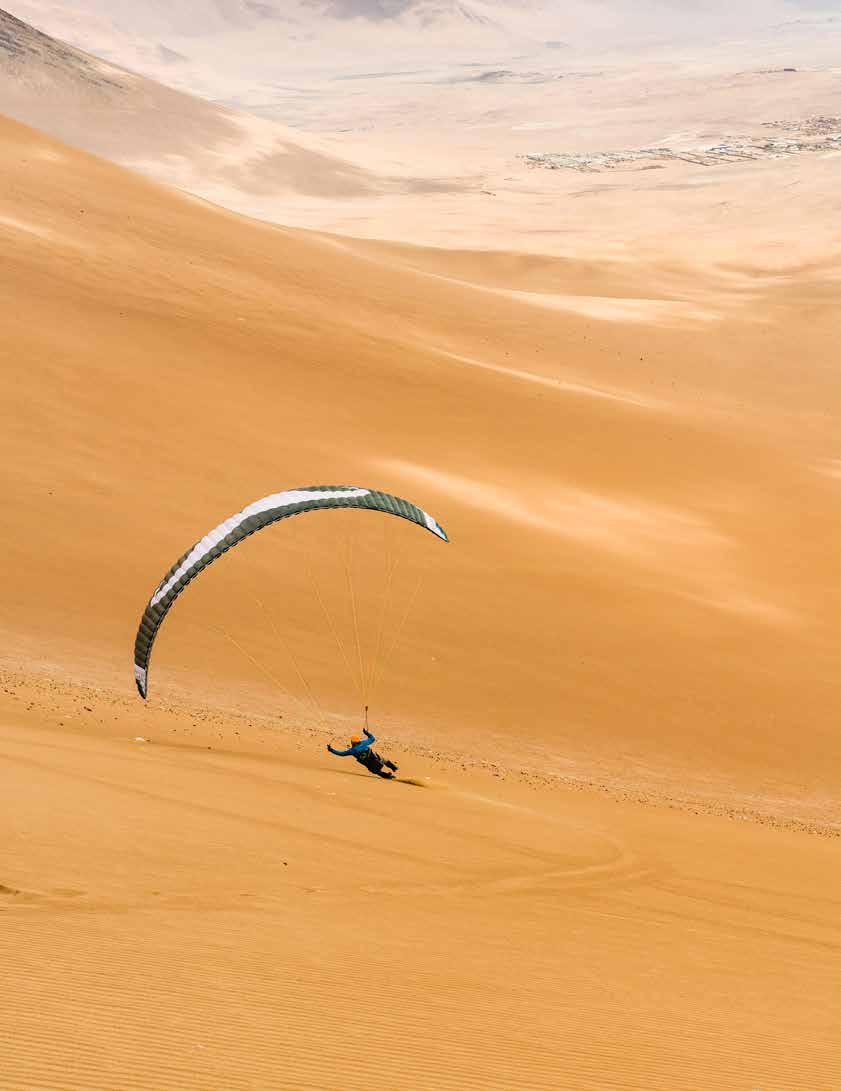
$6.95 Volume 54 Number 2 Spring 2024 HANG GLIDING + PARAGLIDING + SPEEDFLYING
The Alta is a new breed of paraglider! It has per formance equal to gliders in the categor y above, combined with our most cutting edge lightweight paraglider technology And it's easy: it has the reliability and ease of use found in our safest wings
The Alta's stunning glide per formance, light weight, and easy nature make it an attractive wing to a wide range of pilots With nature to a range pilots design and construction techniques used in our X-Alps wings and all of the features which have made our beginner wings so famously safe, it is the most capable and versatile EN A wing that we have ever flown.
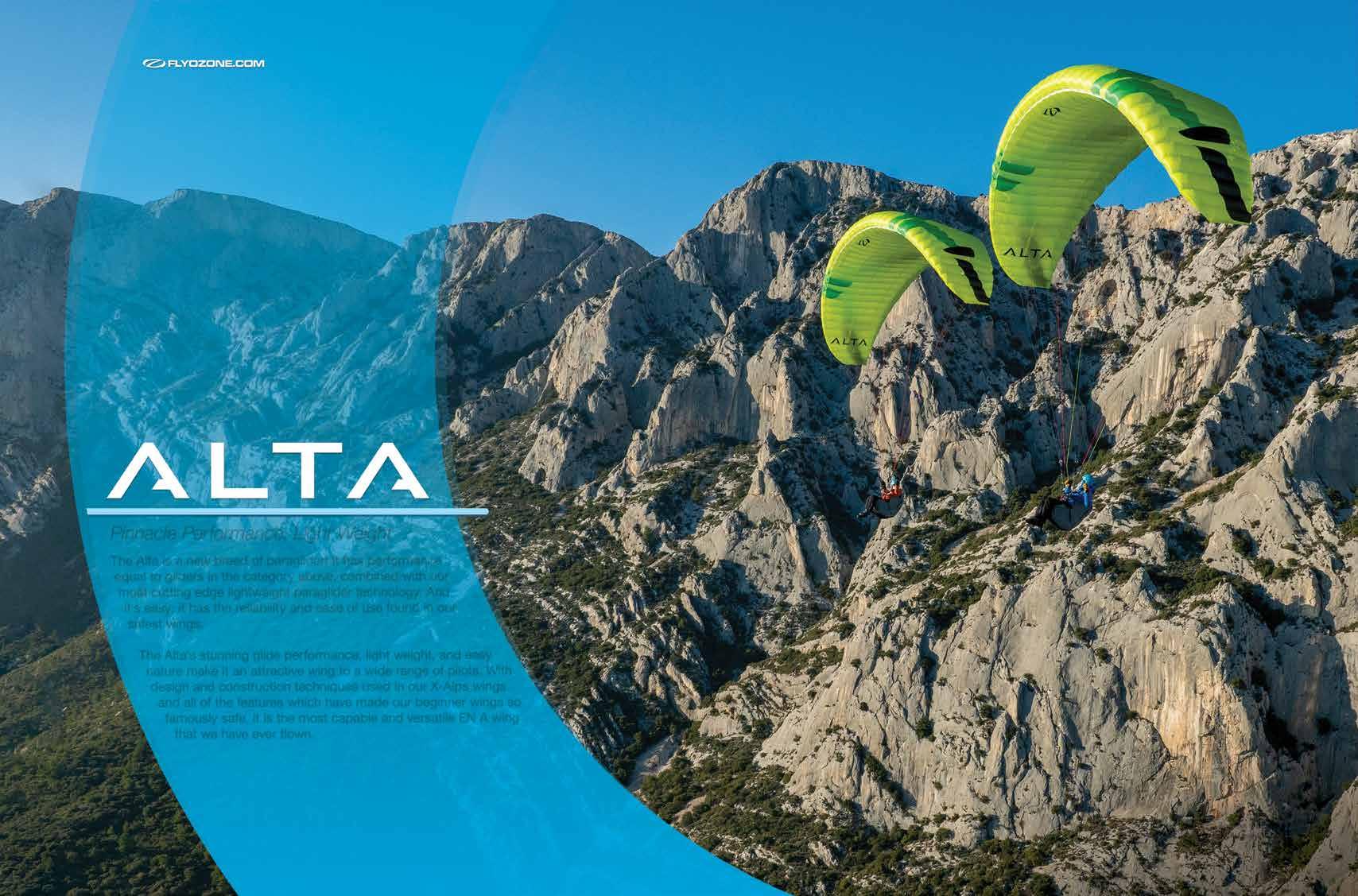
 Pinnacle Per formance, Light Weight
Pinnacle Per formance, Light Weight


HANG GLIDING AND PARAGLIDING ARE INHERENTLY DANGEROUS ACTIVITIES
USHPA recommends pilots complete a pilot training program under the direct supervision of a USHPA-certified instructor, using equipment suitable for your level of experience. Many of the articles and photographs in the magazine depict advanced maneuvers being performed by experienced, or expert, pilots. These maneuvers should not be attempted without the prerequisite instruction and experience.
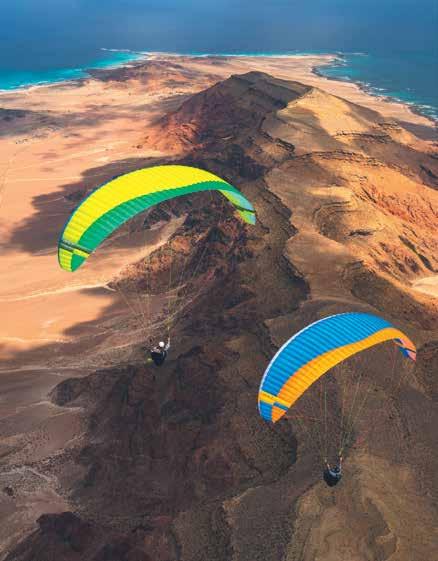
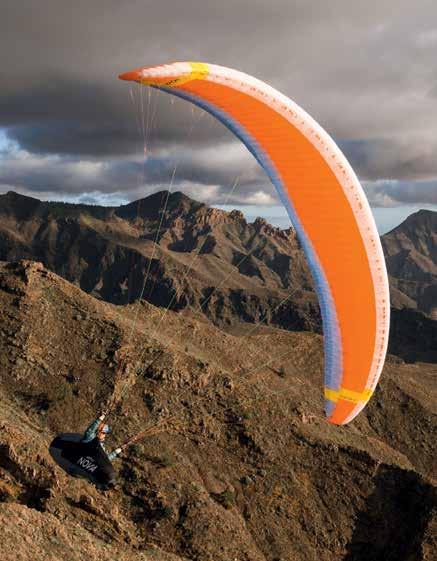
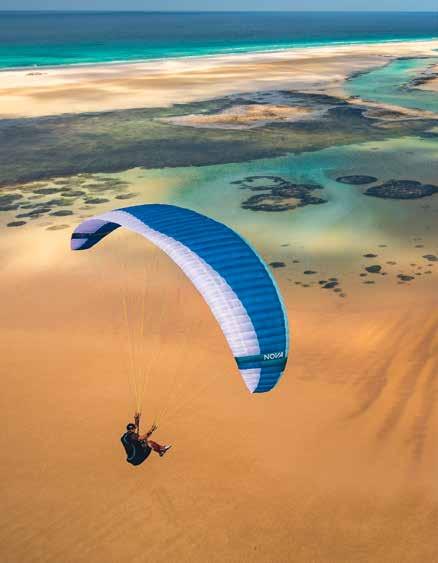
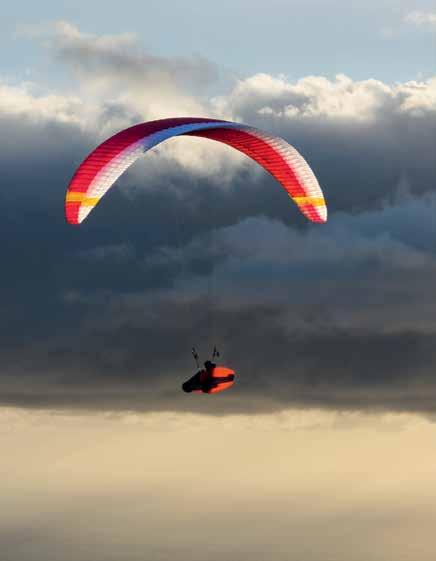
4 USHPA PILOT
©2024 US HANG GLIDING & PARAGLIDING ASSOC., INC. All rights reserved. No part of this publication may be reproduced, stored in a retrieval system, or transmitted in any form or by any means, electronic, mechanical, photocopying, recording, or otherwise without prior written permission of USHPA. POSTMASTER USHPA Pilot ISSN 26896052 (USPS 17970) is published quarterly by the United States Hang Gliding and Paragliding Association, Inc., 1685 W. Uintah St., Colorado Springs, CO, 80904 Phone: (719) 632-8300 Fax: (719) 632-6417 Periodicals Postage Paid in Colorado Springs and additional mailing offices. Send change of address to: USHPA, PO Box 1330, Colorado Springs, CO, 80901-1330. Canadian Return Address: DP Global Mail, 4960-2 Walker Road, Windsor, ON N9A 6J3. Croak and Cluck by Harry Martin 6 One, Two, Three... Go! by Kate Eagle 12 Prepping for the flying Season Committee Updates by Liz Dengler 14 Who the Hell Flies the Swell by Lisa Verzella 18 Flying since the '70s... Innovating Today by Erika Klein 24 Travel Report: Iquique, Chile by Calef Letorney 30 The World Hang Gliding Championships by Mick Howard 36 A Weekend at Slide Mountain by Richard Sibley 42 The Descentionists by Scotty "Dobbo" Dobson 44 The making of a speedflying film Truth in Advertising by Pete Lehmann 48 The 2022 and 2023 Texas Go Long Events Fly-in with a Mission by Jugdeep Aggarwal 54 20 years of the Northern California XC League Editor 7 Association 10 Calendar 60 Classifieds 61 Ratings 63 Performance Paragliders Versatile by design www.nova.eu/ion-7 The XC machine www.nova.eu/mentor-7 Hybrid 2.5-liner www.nova.eu/mentor-7-light EN/LTF B HIGH-END EN/LTF B Lightweight versatility www.nova.eu/ion-7-light www.superflyinc.com info@superflyinc.com 801.255.9595
Letorney toes the dunes of Iquique, Chile. Cover photo by Ryan Dunn
SPRING 2024 Calef

Jeff
Erika
SUBMISSIONS from members and readers are welcome. All articles, artwork, photographs as well as ideas for articles, artwork and photographs are submitted pursuant to and are subject to the USHPA Contributor's Agreement, a copy of which can be obtained from the USHPA by emailing the editor at editor@ushpa. org or online at ushpa.org. We are always looking for great articles, photography and news. Contributions are appreciated.
ADVERTISING is subject to the USHPA Advertising Policy. Obtain a copy by emailing us at advertising@ushpa.org

ERRATA
Deep apologies to Kari Castle for the misspelling of her last name in the Winter 2024 issue. There is no excuse for the misstep. Kari, have you considered a name change? The alliteration with Kastle is quite nice...
Send your pitches to editor@ushpa.aero. Martin
: As you may have seen in our recent newsletter, we have some exciting news—USHPA has officially increased the contributor budget by 30%! I firmly believe in paying contributors for their great work, and this increase in budget will allow for a corresponding increase in rates, a goal we have worked toward since I took on the role of editor.
On top of the increase in rates for contributions, we have also changed up our submission process. For those who have contributed to the magazine in the past, the biggest change you’ll see is that the confirmation email you’ll receive after signing the Contributor Agreement will auto-direct you to our new online platform for uploading content!
My hope is that this new platform will be more user-friendly and provide an easier experience for uploading your stories and photos.
Once your pitch has been accepted and you’ve signed the Contributor Agreement, you can simply save all your story items into a single folder and upload that folder all at once! You’ll notice the email and name fields are now required. That’s so that I know how to get in touch if I need to talk through edits with you. To see more about the new process, check out our Contributor Page ( https:// www.ushpa.org/page/contributors.aspx ). I know that change can often feel hard. But in this case, I am hopeful that we’ve streamlined the process for both you and us.
Remember, though, an increase in contributor rates does NOT mean we are only accepting work from “professional” writers and photographers. This is your publication, and I want to hear from everyone. I am committed to curating a magazine that is balanced with a variety of content, and your stories are what make that possible! That means hang gliders, paragliders, and speedflyers should all send stories and photos about their adventures.
We have a nice variety of articles in this issue, including a great blend of wing types, adventure types (competitions, trip reports, flight reports, and more), innovations, USHPA updates, and advice columns. It’s always a blast to work with all of you, and I am looking forward to the rest of this year!

USHPA PILOT 7
Palmaz Publisher
Managing Editor
Copy Editor
Gillam Art Director WRITERS
executivedirector@ushpa.org Liz Dengler
editor@ushpa.org Kristen Arendt
Greg
Dennis Pagen
Lisa Verzella
Shapiro
Klein
Dengler
EDITOR Liz

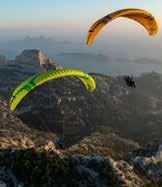
OZONE ALTA
The Alta is a new breed of paraglider! It has a performance equal to gliders in the category above, combined with cutting-edge lightweight paraglider technology.
The Alta’s stunning glide performance, reliability, lightweight materials, and ease of use make it an attractive wing to a wide range of pilots. With design and construction techniques used in X-Alps wings, but with all of the features that have made beginner wings so famously safe, it is a powerful and versatile EN-A wing ready for adventure.
Find more info at www. flyozone.com.
NAVITER OMNI
Naviter is pleased to introduce the OMNI, a new flight instrument in the Oudie family. Getting its name from the Latin word Omni, meaning “all and everything,” the Oudie N’s baby brother is exactly that - a small, lightweight vario and navigation solution that is ideal for all types of pilots and flying. The OMNI features a very bright, high-definition display, precise vario, advanced mapping and navigation, and Fanet+ tracking in a compact device that weighs about the same as a smartphone. More information at flytec.com info@flytrec.com, +1 800.662.2449
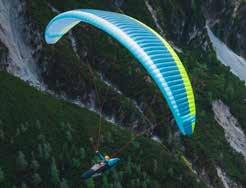
NOVA CODEX
The cross-country paraglider CODEX is a well-balanced, semi-light, 2-liner EN-C glider with 65 cells and an aspect ratio of 6.1. Weights start at 4.2kg for the Size XS and is available in four sizes from 70125kg. It is made from Dominico 30D on the leading edge and Porcher Skytex 27C2 on the rest of the upper and lower surface. Internals are Porcher Skytex 32 hard and ultralight Porcher Skytex 27 hard. The CODEX has Height-Adjustable B-Handles (HAB-Handles) made of carbon and can be adjusted to five levels. This is a perfect first 2-liner EN-C for any qualified pilot. The speed and glide will let you keep up with almost any glider in the category. It comes in three colors; gold, blue and white. This paraglider is available with your choice of bags through SuperFly, Inc. at www.superflyinc.com, +1 801.255.9595, or from your local dealer.

OZONE FORZA 2
The Forza 2 is a complex and feature-rich harness that is comfortable and easy to fly in real XC conditions. The Forza 2 is an aerodynamic, durable, and highly comfortable tool for long and demanding XC missions— ideal for intermediate to advanced pilots. This new design is the highest-performance traditional-fairing harness from Ozone to date. The harness features an anatomically sculpted seat and backrest and two reserve compartments. It also offers high comfort, stability, and passive safety in demanding XC conditions.
Find more info at www. flyozone.com.

8 USHPA PILOT

Do you have questions about USHPA policies, progra ms, or other areas?
EMAIL US AT: info@ushpa.org Let us know what questions or topics you’d like to hear about!
Interested in a more active role supporting our national organization? USHPA needs you! Have a skill or interest and some time available?
VOLUNTEER!
ushpa.org/volunteer
For questions or other USHPA business +1 (719) 632-8300 info@ushpa.org
EXEC DIRECTOR
Martin Palmaz
The Evolution of Free Flight Insurance
: It is hard to believe, but USHPA’s insurance crisis happened over eight years ago. Previously insured by Lloyd’s of London, USHPA was informed in the summer of 2015 that the policy of one of the larger schools, which had no claims, would not be renewed. It quickly became evident the same was happening to all the other schools and the entire industry, including USHPA. This loss of insurance threatened to eliminate access to our treasured flying sites and the sustainability of our sports. There were only a few months to come up with a solution.
This crisis was exacerbated by the fact that other reputable carriers were unwilling to cover our sports. Only one option remained: to form our own insurance company. After a tremendous effort by a small but dedicated group, USHPA raised the necessary capital (thanks to all our donors!) and created the Recreation Risk Retention Group (Recreation RRG) to insure our flying activities nationwide.
Like any startup, Recreation RRG went through the intense initial phase of creating everything needed to operate and issue insurance. USHPA also had to
modify numerous policies and procedures to accommodate new requirements and risk management. There wasn’t much time, and what usually would have taken two years was done in 10 months. Despite these enormous challenges, Recreation RRG has accomplished amazing milestones over the past eight years and remains our best option to ensure the future of free flight for years to come.
Why bring this up now? Because the free flight community is still mourning the loss of the “good old days.” We had a good situation for many years—too good, in fact—which is why premiums were rising rapidly and why Lloyd’s of London ultimately dropped us. The free flight insurance industry is evolving, and we must continue making adjustments so our sports have the coverage and access to keep them alive and thriving.
Between 2009 and 2016, USHPA’s insurance premiums more than doubled, increasing at an average annual rate of 13% per year. It was an unsustainable increase and still insufficient to keep our previous carriers from dropping us. While insurance premiums have always
The United States Hang Gliding and Paragliding Association Inc. (USHPA) is an air sports organization affiliated with the National Aeronautic Association (NAA), which is the official representative of the Fédération Aeronautique Internationale (FAI), of the world governing body for sport aviation. The NAA, which represents the United States at FAI meetings, has delegated to the USHPA supervision of FAI-related hang gliding and paragliding activities such as record attempts and competition sanctions. The United States Hang Gliding and Paragliding Association, a division of the National Aeronautic Association, is a representative of the Fédération Aeronautique Internationale in the United States.
been a significant portion of USHPA's operating budget, they aren’t nearly what they would have been under our old carriers.
One of the largest components of those premium increases was the commercialization of the USHPA's programs (solo and tandem instruction). The General Liability and Professional Liability policies were never meant to be the only coverage for commercial activity, but they were ultimately being used that way. That meant premiums weren’t accurately covering the actuarial risks, so premiums were rising accordingly. Under Recreation RRG, those are now appropriately structured and accounted for by the relevant parties. Since its formation in 2016, Recreation RRG has achieved an unimaginable feat: keeping premium increases (avg. 4.6%/year) far below the standard US market trends of an average of 18% per year for the same period. This represents a savings of over two million dollars.
From the start, Recreation RRG had a challenging job. Not only did it need to take over insuring our sports, but it also had to assist and educate USHPA, chapters, and members on implementing risk management to begin changing the old paradigm. These measures have been the keystone for keeping premium increases down and below market trends. The more we save on insurance, the more we can spend on USHPA programs, and the less likely we are to raise dues.
Risk management has been the most challenging aspect of our evolution. Managing this to the satisfaction of external regulators, reinsurance carriers, and actuarial analysts couldn’t be more culturally divergent for a bunch of risk-tolerant free flight pilots, yet it is necessary for our success. Hindsight
is 20/20, and while we can’t change the past, we are changing the future.
Several years ago, USHPA formed an insurance sub-committee to improve risk management and other elements of the process. Recreation RRG and USHPA's participation in this committee is how we share our mutual needs and make suggested adjustments to procedures and policies for both organizations. Your continued feedback helps us understand your challenges and is an important element in what we discuss and work to improve. Insurance is inordinately complex, but every stakeholder is committed to improving the process wherever possible.
After the 2015 insurance crisis, the potential loss of coverage is always an underlying concern. If Recreation RRG fails, we risk losing access to most of our iconic sites around the country and the ability for event organizers and schools to operate with the necessary coverage. Our collective efforts over the years have been to improve and protect this resource and keep it affordable. Recreation RRG and USHPA have worked diligently to hold rates near inflationary levels, which is vastly better than the broader insurance market. In a mutual effort to protect this resource, USHPA recently approved restructuring the Recreation RRG to allow other sports, like parasailing, to join. After forming the Recreation RRG and seeing similar challenges in other recreational sports, it is clear Recreation RRG fills a broader area of need. This strategic step in growth will help strengthen Recreation RRG’s position to provide coverage in the future.
The success of this new evolution is apparent in Recreation RRG’s achievements over the past eight years and those still to come.
Bill Hughes President president@ushpa.org
Charles Allen Vice President vicepresident@ushpa.org
Julia Knowles Secretary secretary@ushpa.org
Pam Kinnaird Treasurer treasurer@ushpa.org
Martin Palmaz Executive Director executivedirector@ushpa.org
Galen Anderson Operations Manager office@ushpa.org
Chris Webster Information Services Manager tech@ushpa.org
Anna Mack Program Manager programs@ushpa.org
Maddie Campbell Membership & Communications Coordinator membership@ushpa.org
BOARD MEMBERS (Terms End in 2024)
Bill Hughes (region 1)
Charles Allen (region 5)
Nick Greece (region 2)
Stephan Mentler (region 4)
James Bradley (region 5)
Joseph OLeary (region 5)
BOARD MEMBERS (Terms End in 2025)
Julia Knowles (region 1)
Nelissa Milfeld (region 3)
Pamela Kinnaird (region 2)
Takeo Eda (region 2)
What's your region? See page 13.
USHPA PILOT 11 10 USHPA PILOT
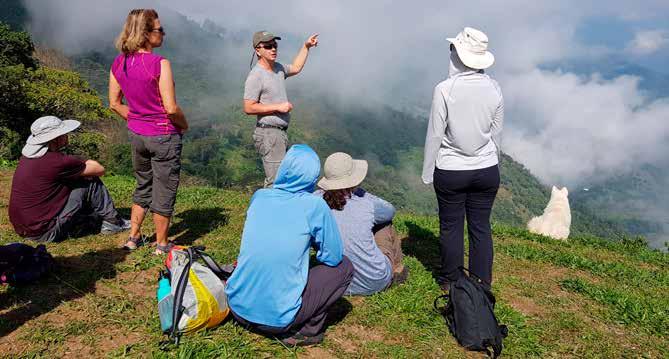
One, Two, Three... Go!
Prepping for the flying Season by Kate Eagle
: Flying season is here, and we can’t wait for our feet to leave the ground! Now, more than ever, it is time to pause to ensure another fantastic day in the air. A simple 3-section self-questionnaire can help us prepare before we arrive at our flying site. Here are some questions to consider as you prepare to fly:
Gear: How familiar am I with this gear? Is it new? Have I recently inspected my equipment for line breaks and frays? Are the glider and lines sorted and free of tangles and debris? Has my reserve been repacked within the last year?
Site: How familiar am I with this site? Have I read the site guide, and should I seek out a site intro by a more experienced pilot? What types of conditions might I experience at this site? What are potential hazards?
Pilot: What is my current physical and mental health? What is my current skill level (not rating, but skill level)? Am I prepared for the conditions that I might encounter? Am I mentally present? What hazards do I present to myself —in other words, what are my weak-
nesses, and how do I manage them? Let's break each down a little more.
Gear: Ensuring your gear is ready to fly starts from your first purchase and continues throughout the seasons. Have you invested in quality gear? If cheap is your priority, you may be setting yourself up for an accident. Ensure you have a professional inspect your equipment for airworthiness before taking flight. Your life is literally hanging by a thread, so make sure you invest in quality threads!
Dedicate some time to removing debris, like sand, twigs, and rocks from your glider immediately postflight. This will prolong the life of your investment and may prevent a mishap later. Repack your reserve yearly (or more often if your reserve gets wet or soiled). If you’re unsure how to repack your reserve, pay a professional to do it for you or seek a repack clinic near you to learn how.
Between flights, inspect each line for breaks or frays. Inspect your glider for wear, especially along the
leading edge. Even pinholes here can noticeably affect a glider’s performance. Check your harness, especially where metal bits rub against the fabric. Do the buckles close securely? Are your carabiners locking and in good condition?
Site: When determining where to fly, keep in mind the weather conditions and how familiar you are with the site. Exploring new sites can be fun, but make sure you have someone with you and seek out a pilot familiar with the area to give you a site intro, if possible. Always read the site guide before you show up at launch.
Site access is usually maintained by a fragile relationship with at least one landowner. You want to make sure you know where you can and can’t land to avoid complicating those relationships. Understand the conditions of the moment and the potential conditions you might experience as the day progresses, both on launch, in the air, and in the LZ. And keep in mind that there may be other hazards present, like distractions from onlookers, air traffic, friends, etc.
Pilot: Honest self-evaluation is much more of a challenge than evaluating the external stuff, like gear, weather, and the site. However, this area is probably the most critical. Make sure you’re staying current with your flying skills. Many of us get busy with life, and before we know it, months have passed between flights. Has it been long enough since you’ve flown that you might benefit from a refresher?
Check in with your original instructor or mentors, or find a school offering refresher courses or tours that offer in-depth critiques of your skills. There are many options for pilots wishing for special skill instruction or just a refresher on basic skills. In the off-season, numerous clinics and schools offer tours to practice skills


Pilots participating in skill-building clinics across the globe. Photos
and maintain (or reestablish) currency in forgiving locations. There are also many options for SIV clinics both in the U.S. and abroad, that will allow you to learn the limits of your glider’s performance and deflation recovery.
Slowing down and asking yourself a few honest questions about your current skill level could mean the difference between another day in paradise and a trip to the hospital. From there, you can prepare as best as you can and make a flight plan with an awareness of hazards.
Finally, get out there and go!
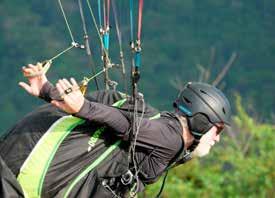


USHPA PILOT 13 12 USHPA PILOT
Brad Hill offers tips during a skill-building tour in Columbia. Photo by Kate Eagle.
Colombian pilot, David Jaramillo above Jardin, Colombia. David provided a site introduction to a group of pilots from Oregon, USA.
| | | | | | | | | | | | | | | | | | | | | | | | | | PREPARATION
by Brad Hill and Kate Eagle.

COMMITTEE UPDATES
: Committees are integral to the organization and function of USHPA. These indispensable volunteers work tirelessly to help the organization effectively support the community, maintain memberships, and fight for members' right to free flight. It’s been a while since we’ve published updates from our committees. As such, we wanted to offer a brief compilation of their work over the last few years. The reports below list the committee, their area of focus, and what they’ve been working on.
If you’d like to volunteer or reach out to make suggestions and offer feedback for the committees, you can find a list of emails on the USHPA website on the Committees and Staff page: https://www.ushpa.org/page/team.
NAA Encourages pilots of all levels of experience to set records. Dozens of records are established each year. Know the rules before you fly.
Your FAI Sporting license must be valid.
Your Official Observer must not only be a member of USHPA, they must be independent and not be perceived to have a conflict of interest.
Initial notiication of a record claim must be filed via the NAA web site within 72 hours of the attempt.
Learn more at naa.aero/records
National Coordinating
The National Coordinating Committee works in several ways to support USHPA members engaging in free flight activities: Initiate and maintain contact and communication with federal government agencies and other national and international agencies (i.e., FAA, NPS, NFS, etc.) whose policies and decisions may impact the rights and privileges of USHPA members; Monitor and review the development of impending policies, laws, and regulations that may impact the rights and privileges of USHPA members; Advocate on behalf of USHPA members for preserving the rights and privileges of USHPA members.
The committee monitors the Federal Register daily to review pending actions on the part of the federal government that may impact Part 103
Liz Dengler, Editor
operations. The committee submitted comment to the FAA in response several proposals and reports including the Uncrewed Aircraft Systems Beyond Visual Line Of Sight Aviation Rulemaking Committee’s final report, in which USHPA opposed the report’s recommended changes to FAR 91.113 right of way rules, and to the Proposed Airworthiness Criteria for the Wing Aviation, LLC Hummingbird Unmanned Aircraft, in which the USHPA requested a dialog to address safety concerns.
Currently, the committee is developing a response to the FAA’s recently published Notice Of Proposed Rulemaking regarding extensive changes to rules governing light sport aircraft and sport pilots.
Technology and Innovation
The USHPA Technology and Innovation Committee is responsible for evaluating and fostering new technologies and innovations in the sport. This could involve creating design competitions for key initiatives, such as developing new safety systems, training tools, VR applications for training and marketing purposes, flight analysis tools, and towing innovations. The committee is responsible for staying up-to-date on the latest research and developments in the field and ensuring that new technologies are safe and effective before advocating for their general use.
The committee is working on developing an electronic logbook to collect relevant data for instructors, USHPA, and RRRG, automating systems for tracker distribution at comps, and
revamping the NTSS software system.
Awards Committee
Each year, the Awards Committee recognizes pilots and supporters who have shown remarkable achievements in promoting all aspects of free flight. These awards include the Bettina Gray Award for outstanding photography, best promotional film, hang gliding instructor of the year, paragliding instructor of the year, speedriding instructor of the year (new as of 2023), pilot commendations, the Rob Kells Memorial award, and others.
Training and Certification
The committee consists of 12 instructors and administrators in the organization. The goal is to create, develop, and implement contemporary methodology in the free flight arena by modifying administrator and instructor pedagogy and curricula to share with new and existing member schools, including exam writing and development. In the long term, the committee would like to bring modern education, skills, and techniques to the pilot membership. The committee helps manage changes relevant to FAA requirements and legal boundaries that will help maintain free flight for the organization by rewriting standard operating procedures (SOPs) as needed. It also helps address concerns within the instructor pool to mitigate safety needs and provide direction toward best practices of instruction.
Over the last few years, the committee has created and developed the new Speedflying Program and added an
REGION 1 NORTHWEST
Alaska Hawaii
Iowa
online syllabus and training supplement for new pilots (glidertraining. org). The committee is currently developing a paragliding SIV program to help standardize the curriculum and certify SIV training and instructors for consistency.
Women’s Ad Hoc Committee
The Women’s Ad Hoc Committee was formed in the spring of 2023 with the goal to support and grow the community of female-identifying pilots in the U.S. The committee represents women of different backgrounds, interests, and skill levels, and it sent out a survey in the autumn of 2023 to all women pilots who are current USHPA members for feedback. The committee is working to create a central way for the community of female-identifying pilots in the U.S. to share knowledge, resources, and more. Since existing resources can be challenging to find, the goal is to have a single place where members can find all the existing resources and start new conversations. The committee is cultivating a few other initiatives, specifically around growing and enhancing the success of women’s fly-ins and supporting female competition pilots.
Finance and Insurance
The committee oversees USHPA's financial and insurance concerns, aiming to safeguard the organization's future through maintaining liquidity, optimizing and protecting cash flows, ensuring cost-effectiveness, upholding financial accountability, and managing its insurance programs, including pilot liability, instructor professional
Idaho Minnesota
Montana
North Dakota
Nebraska
Oregon South Dakota Washington
Wyoming
REGION 2
CENTRAL WEST Northern California
Nevada
Utah
REGION 3
SOUTHWEST Southern California
Arizona
Colorado
New Mexico
REGION 4
SOUTHEAST
Alabama
Arkansas
District of Columbia
Florida
Georgia
Kansas
Kentucky
Louisiana
Missouri
Mississippi
North Carolina
Oklahoma
South Carolina
Tennessee
Texas West Virginia
Virginia
REGION 5
NORTHEAST and INTERNATIONAL
Connecticut
Delaware
Illinois
Indiana
Massachusetts
Maryland
Maine Michigan
New Hampshire
New York
New Jersey
Ohio
Pennsylvania
Rhode Island
Vermont
Wisconsin
USHPA PILOT 15 14 USHPA PILOT
liability, D&O, and property and fire insurance. The USHPA RRRG Insurance sub-committee works to provide an ongoing communications forum to discuss and evolve policy and contractual issues between the two organizations.
Over the past year, the committee reviewed and provided guidance on investments that have improved USHPA's financial position, oversaw the reduction of various budget expenditures, worked to streamline the annual chapter renewal process and make the risk management plan process more collaborative, incorporated annual “hamburger flyins” into the annual chapter renewal process, and created the certified non-commercial instructor program so that volunteer instructors could continue to operate with insurance coverage.
2023 was particularly challenging as inflation significantly drove up insurance costs. The USPHA board sought to rationalize coverage and more closely link insurance costs with the source of those charges. This resulted in changes to international coverage, lower coverage caps, and chapters carrying significantly more of their own insurance charges. However, the USHPA board recognized that chapters need time to adapt and implemented a one-time subsidy to assist chapters through the transition. The subsidy was administered by the sub-committee, and a second year of subsidy has been requested through the 2024 budget process to assist with the second transition year. This past year also saw a significant structural change to the RRRG as its bylaws and articles of incorporation were amended to support expanding coverage into additional recreational sports. Operating a national insurance company that has to meet the underwriting, accounting, actuarial, and oversight requirements of the regulators and maintain a viable business profile is challenging. It was necessary to increase the base of the insurance pool to provide a more secure and sustainable future. The USHPA RRRG Insurance Sub-Committee led the RRRG and USHPA board discussions supporting these structural changes.
Current projects to support the membership include working on the operational budget for 2024, further improving the organization's investment
“Indispensable volunteers work tirelessly to help the organization effectively support the community.”
policies and opportunities, working on the 2024/25 USHPA Insurance Policy renewal, and streamlining and simplifying the event insurance process—a goal of the USHPA RRRG Insurance Sub-Committee this year.
Site Development & Chapter Support
The committee has a new class of volunteers, including club officers from chapters across the U.S. with first-hand experience with insurance and chapter renewals, developing site guides and risk mitigation plans, and managing club websites, waivers, and dues. The committee is vested in examining the challenges clubs face.
In the coming year, the committee hopes to identify ways to streamline chapter renewals and provide additional resources beyond a pathway to insurance coverage for clubs in the U.S.
Clubs are an essential touchstone to members of our sport. The committee looks forward to supporting USHPA chapters and the volunteers who keep them running as resources for local communities, both large and small.
Competition
The Competition Committee handles all things related to hang gliding and paragliding competition sanctioning, competition rulebook, national teams, and NTSS rankings. Over the years, the committee has successfully sanctioned all competitions in the U.S. and coordinated and assisted national teams in preparation for world championships, including fundraising, team selection, travel, and logistics of attending the world championship.
The committee generally focuses on continued/ annual sanctioning and keeping the rulebook up to date. In early 2023, the committee purchased a set
of FlyMaster live trackers for use by all U.S. competitions. Having a set of trackers benefits competition organizers because they don’t have to rent them from out of the country. It offers huge benefits regarding safety during comps and for online (and on-site) spectator viewing of tasks.
Hang Gliding Growth & Development
The committee was created in 2018 and has since identified many barriers to the growth of hang gliding, including inadequate novice gliders and insufficient support for new instructors. Several strategic initiatives were subsequently developed by committee members, including the Wills Wing Alpha novice glider and new tow systems for training. The committee is currently working on new comprehensive materials to support instructors and students and standardize and improve training nationwide. These efforts are all to help expand hang gliding and attract new pilots to the sport that many say provides the closest feeling possible to flying like a bird.
Towing
The towing committee has five main goals: Seek out information on towing methods, equipment, and sites; Promote standards and procedures to ensure safe towing operations; Develop, initiate, and maintain rating programs for towing operations; Review tow-related accidents and fatalities to prevent repetition; Appoint towing examiners in accordance with the requirements of SOP 12-10. The committee hopes to develop a communications platform for tow techs to enable and enhance conversations about towing. The committee is eager to hear input from tow techs, surface tow pilots, and pilots involved with towing on current challenges, better learning tools, and how else the tow committee could direct its focus.
Tandem
The Tandem Committee's mission is to assist with maintaining a safe and accessible tandem program. Responsibilities include promoting safe standards and procedures, developing and maintaining the rating program, and appointing tandem adminis-
trators. The committee is working on filling tandem administrator roles in regions that have a need. It collaborates with the RRRG and FAA to continually evolve safe practices and standards to remain compliant with insurance and regulatory requirements.
Airworthiness/HGMA Transition (ad hoc)
The goals of the committee are three-fold: To port over to the USHPA website a legacy copy of critical hang glider airworthiness information, including the historical list of hang glider models certified to the airworthiness standards of the now dissolved Hang Glider Manufacturers Association (HGMA) and the contents of those standards themselves; If need arises, to establish USHPA Hang Glider airworthiness standards mirroring those of the HGMA and a process and review committee to help hang glider manufacturers certify new models; Answer questions from members regarding hang glider airworthiness.
The technical and informational content of the Hang Glider Manufacturers Association website has been copied and is available on the USHPA website at https://www.ushpa.org/hgma. USHPA members or others who have questions about hang glider airworthiness or the HGMA program can contact the committee chair. There have been no requests from any manufacturers for certification of new hang glider models.
Organization & Bylaws
Per the committee charter, the committee “shall review and process all suggested changes to the Articles of Incorporation, Bylaws, and SOPs.” For details on what the committee has been working on, contact the chair via the email address on the USHPA website.
Accident Review Committee
Per the committee charter, the goal of the Accident Review Committee is to encourage reporting, collect accident data, identify trends, summarize trends for publication, and take forward action to prevent future accidents. For details on what the committee has been working on, contact the chair via the email address on the USHPA website.
USHPA PILOT 17 16 USHPA PILOT
Who the Hell Flies the Swell?
: After decades of hang gliding through the turbulent air of the Mountain West, I never thought I’d be flying a paraglider there in the middle of summer and over the desert. Yet somehow, there we were, our fearless group of four, cruising over some of the most remote, rugged, and rock-laden terrain the state of Utah has to offer.
The San Rafael Swell is an expansive geological wonder of rock, chasm, and bluff delivered in an explosive array of cinnamon colors. Its location in the core of the southeast Utah desert is bounded by rural farmland on three sides and two national parks to the south. The vast terrain is intersected only by Interstate 70 and a few dirt roads, usually passable with a 4WD truck.
Several local Utah paraglider pilots and I had been teaming up the past few summers to attempt new cross-country (XC) routes, longer lines, bigger triangles, and personal best flights. A winter with record-breaking snow coupled with the cold, wet spring of 2023 narrowed our window of the best conditions and prompted us to be vigilant for any good XC days. We also knew that the Southwest monsoon was potentially at our doorstep, and days were gradually getting shorter.
Honing in on the weather forecast about a week out is usually our first step. As the July 4th holiday approached, we scoured global models, XCSkies, and Windy for potential conditions and routes.
Longtime Utah sender Arash Farhang and I often exchange ideas about what might work and then quickly try to line up drivers accordingly. With high pressure in place, a light WNW wind, and a high cloudbase in the forecast, we knew the Salt Creek Range in central Utah would offer enticing routes toward the Swell, Moab, and potentially into Colorado.
On July 2, conditions came together for the go. With a chance of overdevelopment along the most
by Lisa Verzella
downwind route, we chose a line to the ESE toward Moab. Arash teamed up with Kiwi pilot David Chen and chase driver Walter Medellin (also a paraglider pilot) and headed south from Draper, Utah. A second group, Bob McRae, chaser Chris Parrish (also a bi-wingual pilot), and myself, got an early start from Salt Lake City that morning to meet the others.
Our combined initial strategy brought us to the Wales launch just above Wales, Utah, which faces ENE for the earliest launching opportunity. However, once there, we realized the light westerlies were already prevalent, so we bolted over the range to the Horse Heaven launch. There, we met light upslope winds and quickly laid out our gliders to be ready for the first cycles.
After getting in the air, the four of us scratched near and just above launch until the thermals turned on. Arash led the way over the back toward Skyline Drive on the Wasatch Plateau. Though early July, there were still significant patches of snow speckling the high country, outlining the array of lush conifers and rock outcrops. Cloudbase over the Salts was at a chilly 15k (15,000 feet) MSL, which seemed miles high, yet the sink between thermals could ground us in minutes over the high plateau or during valley crossings.
After reaching the east side of the Salts and bleeding altitude over the Sanpete Valley, I found myself low coming into the foothills near Manti. Focusing on finding the next climb, I was pleasantly surprised to see Bob and David in the vicinity as well. We each found an elevator route that lifted us back up over the Wasatch Plateau on to the next crossing adventure.
Arash vividly recalls this leg of the journey. “I found a solid thermal, allowing me to climb back to base
“Only a handful of paraglider and hang glider pilots have traversed this majesty.”
(now almost at 17k). I cruised thermal after thermal across the plateau and into the flats, heading towards the San Rafael Swell,” he says. “The Swell was no less magnificent this time than the other times I have flown over it. The views of the canyons down low and the perfect clouds up high were just magnificent. I hit ripper after ripper, flying with a very comfortable and fast flow towards Moab. I was in ‘Heaven’!”
While Arash was cruising at base, the cloud streets were shifting and pulsing. If you weren’t at base, you had to have the expert timing of Bill Belcourt to jump on the right elevator. Or, in my case, the tenacity to hang on long enough to blunder into a series of short rides on a fast vertical machine. And once again, I spotted David and Bob just below me and searching as well.
While scratching low southwest of Joes Valley Reservoir and still over the plateau, I was preparing
to land along one of the primary off-road vehicle dirt tracks in the area. It was a relatively safe maneuver in those light winds, though far from the main road and potentially inaccessible by a typical 4WD truck. Fortunately, I caught something light and worked it up and out.
With Arash well out in front, Bob, David, and I managed to climb high enough to finish our plateau crossing and beelined for the Swell. Cloudbase was now nearing 18k, and temperatures were at the freezing mark. Deciding to be more choosy with the more readily available thermals, both to expedite the miles gained and save my fingers, I blazed over the pinnacles and pockets of the multicolored sandstone that is the San Rafael Swell.

Only a handful of paraglider and hang glider pilots have traversed this majesty. For me, this was my third time, and I found as many variations on a route theme. The Swell can be overflown from several
USHPA PILOT 19 18 USHPA PILOT | | | | | | | | | | | | | | | | | | | | | | | | | | | | ADVENTURES
Vast mesas of the San Rafael Swell. Photo by Bob McRae.
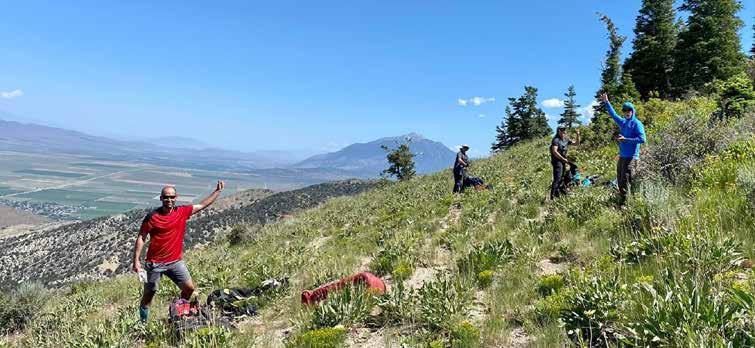
different sites in multiple directions (though, not to my knowledge, heading west). Belcourt notes of the array of routes, “They are a different experience, each with its own areas of commitments.”
On this day, our route was a line similar to the Horse Heaven paragliding site record flown by Cody Mittanck a few years ago (Cody can’t recall the details!). Similar-distance site records were set by hang glider cross-country phenoms Dave Sharp and Paris Williams about two decades ago, though in an NE direction.
Straddling I-70, the Swell again displayed all its glory on this cloud street-lined day. Though it was cold where I was (for the moment), I knew it was sizzling hot on the ground. And there were such large expanses of nooks and crannies that we dared not land.
Bob remembers this area clearly. “At this point, I had been flying for three and a half hours. A voice in the back of my head was tempted to call it. I-70 would be a great place to grab a retrieve. [If I wasn’t careful,] the strong, broken lift I was circling in would carry me across I-70 about 1/2 mile west of the Devils Canyon view area and push me away from the interstate and into an area with no good landing options. I knew a decision had to be made.”
About 1,000 feet above the hot desert rock, Bob chose to push on, tracking a solid thermal into the outback. Flying without oxygen, he was attempting to stay below his hypoxia threshold of 16k. Thermalling through 15k after gaining more than 8,000 vertical feet, Bob abandoned the lift and dove downwind.
Having lost radio and visual contact with Bob a while back, I used Siri to call him on my cell phone, which I had positioned strategically on my flight deck. Bob recalls, “I put (Lisa) on speaker, and we tried to figure out where the other was. I hadn’t seen another glider in over two and a half hours. As we talked, I continued to circle and climb. Then, the strangest thing occurred. It started to snow! I’ve been snowed on in flight before, but it was in winter high above the Wasatch Mountains just below cloud base. Today, I was in Central Utah in July over the desert … it was surreal. I think I shouted in disbelief to Lisa. Then I looked down at my flight computer; my altitude read 16,100 feet. I asked her if I had been slurring my speech, and she said no.”
While I was cruising into the heart of the Swell, with David Chen’s orange glider high above me, Arash was miles ahead. When he had approached the interstate well before the rest of us, Arash recalls,
“I got another decent climb to base just southeast of Green River, this time almost at 18k feet, though once I glided towards Moab, I started to get low again. Trying desperately to regain my position and fly over the edges of the Canyonlands (National Park), I pushed over a few obvious triggers and, after a little searching, found another thermal that slowly but surely took me back high. However, now the winds had turned very north and, at times, even had a hint of east, really slowing down progress. Still, I could now clearly see the potash ponds just west of Moab and their vibrant blue emerald colors.”
As the day was winding down, David and Bob skirted the west edge of Canyonlands, and Arash pushed on toward the Colorado border. A virga line was dropping out downwind of me, so I took a more easterly route, which eventually grounded me well short of the National Park border.
David and Bob landed near each other and were planning (hoping) to be retrieved by separate drivers.
David coincidentally had some friends driving up from Moab, and he was able to direct them to his
landing location. Bob knew he’d be waiting a while for Chris’ retrieve, so he began walking along the road, witnessing a simultaneous, amazing sunset and moonrise.
Intrepid retrieve driver Chris sent me an inReach message right after I landed, letting me know he was 15 minutes away. How incredible to have flown more than five hours and more than 150km over desolate terrain and have your driver right behind! Luckily, I noted a few dirt roads from the air before I landed, which would allow him easy access to me … or so I thought. What I didn’t realize was that the roads in the Swell are sometimes literally lines drawn in the sand.
Chris tells his side of the story. “I thought to myself, ‘Wow, that’s deep.’ I was on somewhat of a road, I guess. It was narrow, with scrub encroaching on either side, but passable in the gray Toyota Tacoma I was driving. The two tracks carved out from the hard pack were separated by more grass and scrub. I was in a desert area between Capitol Reef and Canyonlands National Parks; it was mostly flat and
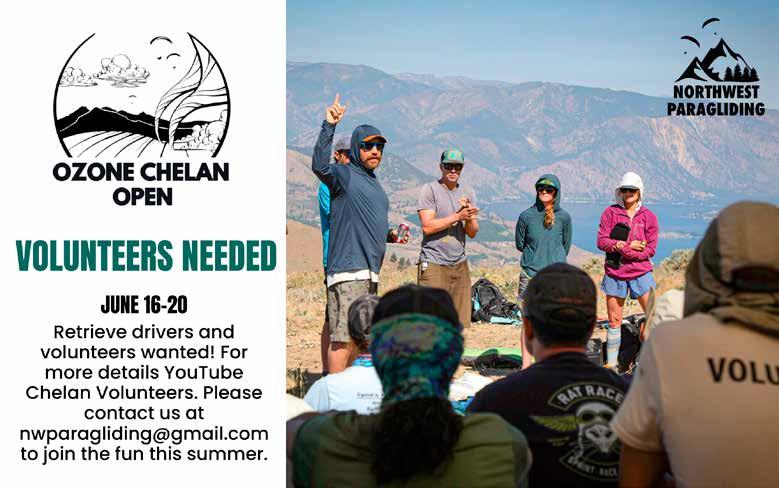
USHPA PILOT 21 20 USHPA PILOT
(L to R) Arash Farhang, Bob McRae, David Chen, Chris Parrish prep at Horse Heaven launch near Levan, Utah. Photo by Lisa Verzella.

beautiful, and the sage-colored scrub was endless to the horizon. Utah deserts have a beauty all their own, and this area is no exception. Sometimes, these routes are sketchy. A gray line on a map can be anything from a 60 mph thoroughfare to a cow path unpassable by anything without four legs. And this was one of those times. The problem this time was wind-blown sand. I was pretty sure the Taco would make it down through the sand, but I was not so sure about making it back up. But hey, my pilots come first; if we get stuck after that, we can both figure it out.”
Seasoned chaser and pilot that he is, Chris managed to reach me despite several areas of six to twelve inches of sand bogging down the truck. Arash was en route to a landing field just shy of the Colorado border and had a retrieve lined up with Walter. Now, it was on to find Bob.
The sun descended while the glorious July supermoon, one day shy of full, ascended amidst the stout red rock features. Luckily, we had some radio contact and knew we could reach him soon. Bob was walking toward us from the south, and aided by moonlight, we soon saw his form coming closer to meet us. A few flashes of his headlamp confirmed he saw our truck approaching. We made the connection and headed back to Salt Lake, all pilots safely retrieved.
This Swell flight was a highlight for Utah Team XC that summer. It was proof-positive that there’s more to cross-country flying than miles or records. From launch to landing to retrieve, the camaraderie accented the phenomenal landscape and stellar weather. May these words and photos inspire you to embark on your own swell adventure!
At first, making the rookie mistake of putting Bob’s location into Google Maps (N-E-V-E-R do this with dirt roads!), we nearly got stuck in the sand mounds that barely had any tracks. Fortunately, just before having to lower the tire pressure, we switched to navigating with the trusty red Utah Gazetteer to find the best drivable route to Bob’s coordinates.
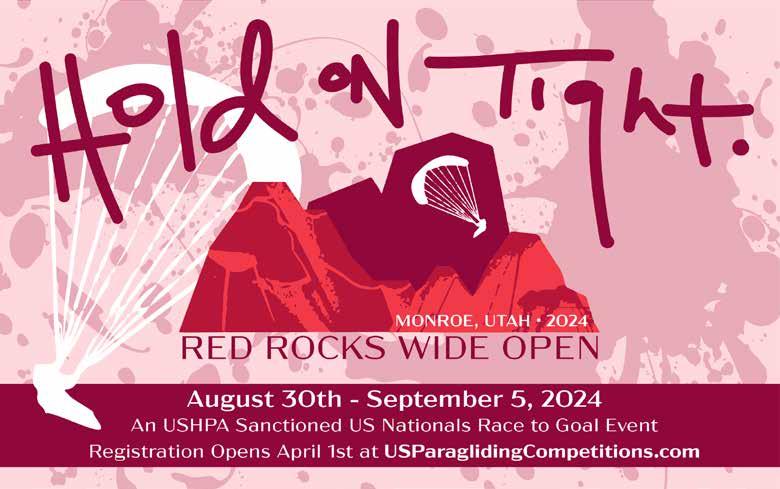
USHPA PILOT 23
Flying above the spectacular carved landscape of the Canyonlands. Photo by Arash Farhang.
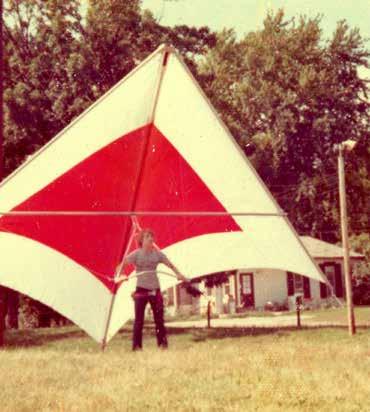

Flying since the '70s... Innovating Today
by Erika Klein
: After 50 years, hang gliding participation has fallen—but dedication to improving the sport is as strong as ever.
On a family trip to Michigan in 1979, John Maloney, then 16 years old, saw three hang gliders launching from the dunes.
“I just remember lying in the sand looking up at these three guys flying like birds, dancing around in the sky,” he recalls. “And I said: I’m going to do that.”
Back home in Minnesota, Maloney split the cost of a tandem glider with his cousin. The two teenagers found training hills through school ads in the United States Hang Gliding Association magazine and would show up to fly, receiving free instruction along the way. “They didn’t know much more than we did anyway,” Maloney says with a laugh.
Decades later, as USHPA celebrates its 50th anniversary, instructors are certified, gliders are professionally
manufactured, and the sport is much safer. Even as hang gliding participation has declined over the years, pilots’ passion for hang gliding and their dedication to improving the sport is as vibrant as ever. Maloney and several other pilots have stuck with hang gliding since the early days, continuing to soar, create, and innovate.
Towing safely with tech Maloney, an airline pilot based in North Carolina, also flies sailplanes in his spare time but describes hang gliding as “epic” and “the real thing.”
“It’s that feeling of taking those slow, accelerating steps to where you’re flying, just leaving the ground with these wings on your back,” he explains. At the same time, he recognizes that adopting some lessons from the airline industry could help further improve safety in hang gliding.
After witnessing a fatal crash following an aerotow
(LEFT) Philip Jones with a 16’ Kilbo Kite built from plans in True Flight by Herman Rice and Dave Kilbourne. Photo by Leonard Dietch. (RIGHT) Flight Simulator.
(TOP) The Kilbo Kite in action. (BOTTOM) Jonathan Dietch launching from Kagel Mountain in Sylmar, CA on his Icaro 2000 RX2, assisted by Joey Fresquez and Ken Andrews, while Joe Greblo displays excellent wire form. Photo by John Partovi.
lockout in 2016, Maloney decided to take action. That year, he started developing and testing a device that clips to the basetube and detects the glider’s bank angle while under tow. In addition to providing a manual release button directly under the pilot’s thumb, the device automatically releases the tow line if the glider starts rolling toward lockout.
The device, Maloney explains, fits the aviation concept of acting as a barrier to potential threats and errors. And it works. On a thermic tow at the 2019 comp in Big Spring, Texas, Maloney watched the tug hit lift at 50 feet and shoot up in front of him as his glider rolled left toward lockout. Just as he decided to press the manual release button, the auto-release activated, freeing him from the tow and returning him to level flight in time for an uneventful landing.
Now, Maloney is continuing to refine his design and introduce it to schools. “If everyone flew with it,” he says, “I don’t see how lockouts could happen anymore.”
Lifelike training without the risk
Using technology to enhance the hang gliding experience has also been a recent focus for Thomas Low, a pilot in Northern California. Low began his hang gliding journey in 1971 when he built a hang glider for his fifth-grade project. His classmates towed him up to about a foot off the ground before the glider snapped into pieces.
Undeterred, Low begged his parents for hang gliding lessons, eventually paying $28 for two days of instruction a few years later. “Everything else, I’ve taught myself,” he says.
Low eventually graduated to a full-time career in engineering. Still, he continued hang gliding and working to improve the sport. As a research engineer who worked in flight simulation, Low had wanted to build a realistic hang gliding simulator for years. He got his chance during the COVID-19 pandemic when he was isolated for 10 days in his kids’ old bedroom.
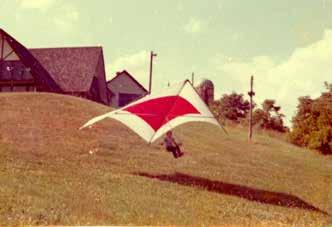
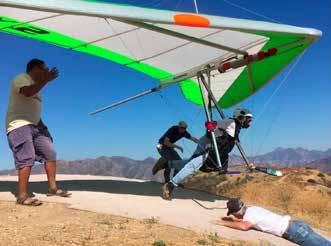
“That’s when it began, and since then, it’s consumed way, way more time than it probably should have,” he says. “But it’s my way of giving back to the sport a little bit and maybe changing the trajectory of the sport in a small way.”
Low drew on his experience as a skilled aerobatics competitor, instructor, and pilot of five decades to make a virtual reality simulator called Freeflight Experience that successfully mimics the handling and reactions of real hang gliders.
“Even as an engineer, I can’t believe what he’s done,” says Steve Pearson, chief design engineer and managing partner at Wills Wing from 1977 to 2022.
Recently, Low set up his simulator at the UC Berkeley Hang Gliding Club’s holiday party. “Some of the students, after 15 or 20 minutes of flying, were just completely dialed in, actually thermalling and soaring,” says Low. “And these are pre-Hang 1 pilots.”
Low hopes his simulator can help keep former pilots engaged in the community, reach a pool of potential new pilots (including gamers), and offer a risk-free
USHPA PILOT 25 24 USHPA PILOT
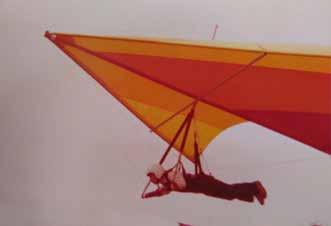

environment for incoming or current pilots to learn new skills.
“Hang gliding is hard to do as frequently as we would like, especially for those who have to drive for hours or can’t fly in the winter,” Low notes. “The simulator gives people the opportunity to keep their skills at the leading edge so that when they do fly, they’re that much better, and they’re that much more inclined to be safe as well as enjoy the experience more.”
Low also plans to build more community features into the simulator, such as virtual competitions. “I give hang gliding credit for shaping my life in a lot of different ways,” says Low. “I would hate to see that
not be something others have access to.”
From watching to flying
Sharing hang gliding through media is also important for Southern California pilot Jonathan Dietch. Dietch has been flying hang gliders since 1973 but stopped for several years due to medical issues. Other pilots’ online flying videos helped get him back into the sport, and Dietch has since returned the favor. His YouTube videos are well known for narrated long flights, often showing potential cross-country routes complete with 3D track animations and flight instrument data.
“I think it’s important to encourage different pilots

to upload videos and share them,” says Dietch, adding that many pilots have told him his videos brought them into the sport. “I believe that viewers of hang gliding videos want to have a story and not just imagery and that sort of thing, but they want to envision themselves exploring the sky and different places to fly.”
Dietch also continuously seeks other ways to improve the sport, from promoting a unique drogue parachute and testing holographic films for glider visibility to making basetube skids.
“I think the future [of hang gliding] is already positive, although it may not resemble people’s preconceptions,” he says.
Incorporating and developing new ideas
Of course, schools are the most important places for supporting new pilots and innovations. Tiki Mashy has been hang gliding full-time since she started in 1980 as a teenager. She also has her private pilot’s license and is a certified flight instructor, with hang gliding. “It was
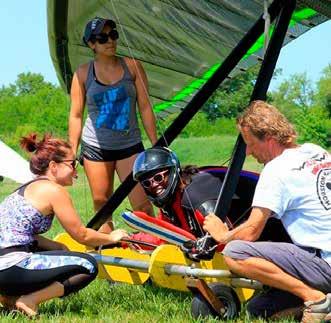
like, ‘Yep, this is it, that’s what I’ve been dreaming of,’” she says.
Besides serving the sport on USHPA’s board of directors on and off since 2001, Mashy opened her school Cowboy Up Hang Gliding (now based near Houston,





USHPA PILOT 27
FOR MORE INFO EMAIL: MARKETING@KITTYHAWK.COM Ye�s TeachingtheW�ldtoFly Since 1974 SUBMIT YOUR KITTY HAWK KITES STORIES FOR OUR 50TH ANNIVERSARY BOOK HELP US CELEBRATE OUR ANNIVERSARY! MAY 16-19, 2024 JOCKEY’S RIDGE JOIN US FOR THE 52nd JOCKEY’S RIDGE MAY 16-19, 2024 JOIN US FOR THE SUBMIT YOUR KITTY HAWK KITES STORIES FOR OUR 50TH ANNIVERSARY BOOK HELP US CELEBRATE OUR ANNIVERSARY! Tiki Mashy preps to tow up.
(LEFT) Thomas Low flying the Standard Thorton in 1974. (RIGHT) Thomas Low flying at Tollhouse. Photo by Zac Majors Flight simulator game in Rio.

Texas) in 2003 and has been among the first instructors to adopt many innovations. These include Low’s VR simulator, the Wills Wing Easy Flyer for simpler launches and landings, and 360-degree cameras to record unique angles on tandem flights.
“I think innovation is great, and I’m the first person to hop on a great new idea and give it a go,” Mashy says. “Innovation is important if this sport is not only going to grow but also survive.”
She has come up with her own new ideas, too, like running parachute clinics that since 2016 have involved swinging pilots from a large apparatus rather than having them simply toss their chutes from a stationary control frame. Pilots are released from the top of the swing without warning while the crowd below shouts to create a chaotic environment, simulating the feeling of an in-flight emergency. “It’s quite a thing, and it’s great because it brings the community together,” Mashy says.
Mashy contends that hang gliding’s best days are still ahead. Still, she believes in adapting to the times— whether that’s incorporating new technology and techniques or encouraging hang glider and paraglider pilots to work together.
“We all want the same thing, and we need to try to
lift each other up,” she says. “Free flight’s not free; we can’t just run out there and do whatever we want as we could back in the ‘80s. It’s an obligation, a responsibility, and we have to preserve it.”
50 years in: “Now is so much better.”
After hang gliding for decades, all four pilots agree that the sport is a way of life. The drop in pilot numbers over the years may indicate a sport in decline, and there are undoubtedly challenges to overcome, among them insurance costs and the loss of site access. Still, many current pilots’ commitment to improving the sport—and the perspective of these original pilots on hang gliding’s evolution—reveal optimism about the future.
“To some degree, the sport’s at the best place it’s ever been to provide opportunity for people who want to fly hang gliders,” says Maloney, pointing to several longtime, highly rated schools around the country. “It’s not in every corner like it used to be, but the places we’re still flying are very good for flying, and the equipment is very good for flying. So all the excitement is still there, only it’s better. From what we had in the ‘70s to what we have now—what we have now is so much better.”
INTRODUCING
Accident Assistance Fund (AAF)
Members Helping Members in Times of Need
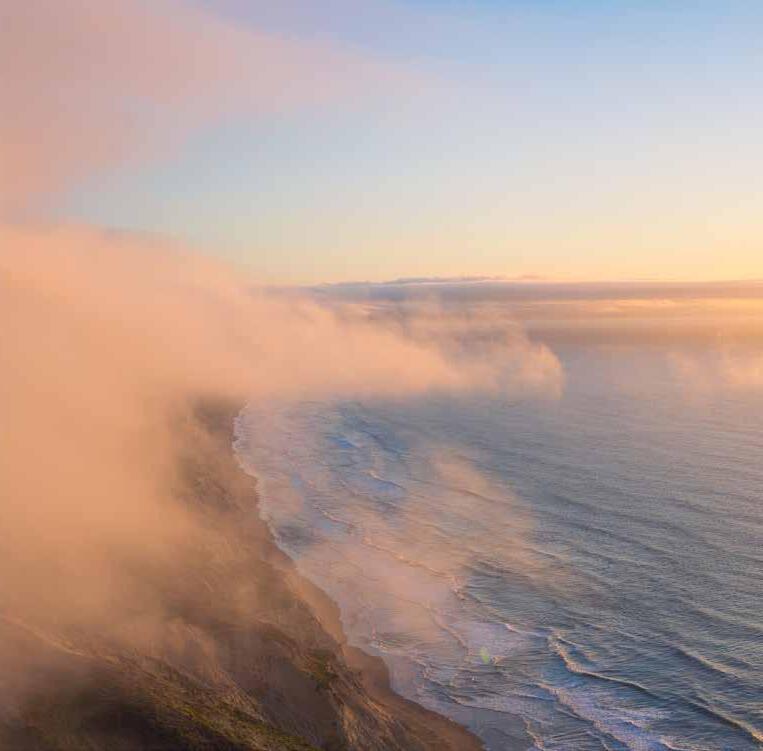
The AAF is the first initiative launched by the recently created Development Committee. The AAF will help cover medical and other expenses resulting from free flying accidents*. If you’re interested in helping your fellow pilots in times of need, please consider making a tax-deductible gift to the AAF. To kickstart the AAF, two generous members have agreed to donate $5,000 each, for a total of $10,000 in matching funds. This is an incredible opportunity to double the impact of your contribution to the AAF.
Scan QR code for more details on the AAF and how to make a tax-deductible donation.

* The AAF will only have access to funds donated by members and earmarked for the AAF. The AAF is not insurance and is not intended to be a replacement for insurance, but rather to help with insurance deductibles and unforeseen medical and other expenses in times of need. USHPA encourages all pilots to practice safe flying and stay current and maintain proper medical insurance coverage. Details of the AAF are available on USHPA’s website including eligibility requirements, application process, and fund management.
USHPA PILOT 29 28 USHPA PILOT
Presenting the hang gliding flight simulator at Coupe Icare.
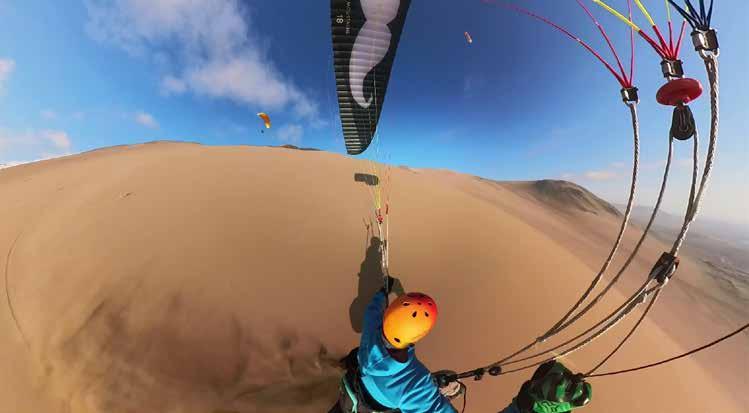
Travel Report: Iquique, Chile
by Calef Letorney
: Iquique, Chile, is a paraglider’s paradise located on the edge of the Atacama Desert, where the Altiplano (high plains) meets the sea. The driest region on the planet, rainy days are not a thing in Iquique. The locals say you can fly 360+ days per year, but that doesn’t mean it’s always worth a visit; much of the year tends to be cross and windy. October and November provide the best conditions with higher cloudbase, mellow winds, and favorable wind directions. That also happens to be a great time of year to escape the cold rainforest of Vermont, so this past October, I led a tour to Iquique for the first time since the pandemic interrupted our plans in 2020.
The rub, and why Iquique isn’t nearly as popular as Valle or Colombia, is getting there. Traveling to Iquique is a 24+ hour mission with unavoidable redeye flights
both ways. Round-trip tickets cost over $1,200 before ancillary fees. IQQ airport is served almost exclusively by Santiago, Chile, so you must fly several hours south and then back north. This is enough to turn off most pilots, but those willing to make the journey will be rewarded with near-guaranteed flying in an otherworldly landscape.
To catch a direct flight to Santiago, we drove seven hours south from our home in northern Vermont to JFK Airport in New York. Of course, we experienced the NY pastime where they use the roadways as a temporary parking lot. This foreign, unpleasant, and confusing experience can be paid for by check or credit card when an exorbitant toll bill arrives by mail weeks later. We certainly questioned our decisions while fighting our way into the belly of the beast. Fortunately,


our group checked in for our flights with ample time, and the rest of our travels went smoothly. We logged a full eight hours of shuteye before the sunrise over the Andes welcomed us to Santiago. The breathtaking views renewed my interest in flying the surrounding mountains … someday. We cleared Chilean customs and had time for breakfast before catching the three-hour flight back north to Iquique. The ap-
proach to the IQQ airport also offered excellent views, this time of a very different landscape; here, the brown, lifeless Altiplano falls sharply to the sea.
This part of Chile has a rich heritage that dates back thousands of years as various cultures have traded with and fought wars over this gateway between the sea and the mountains. The cuisine is mainly fresh-caught seafood—I imagine a shellfish allergy is more perilous than paragliding. Don’t miss the opportunity to stop in the fishing villages where restaurants cook the day’s catch in every manner possible.
Chileans are warm and friendly, but it’s definitely the “Louisiana of Latin America,” so you can expect some difficulty communicating. Imagine talking with somebody from the Bayou but in Spanish. A large portion of the vocabulary is unique to Chile, and the rest of the words are so jumped and abbreviated that even native Spanish speakers are in for an adventure.
Bright-eyed and bushy-tailed, our team of instructors and students met our local drivers at the IQQ airport, just 30 minutes from the city. After a quick huddle, we unanimously decided to stop along the way for an afternoon soaring session at the Palo Boque dune. This is one of those rare sites where pilots start at the bottom and kite up the dune to launch. Once soaring above the 200-foot tall launch ridge, it’s an easy transition to the main slope that climbs roughly 2,000 feet and extends for hundreds of miles in each direction. Here, airspace and lack of roads (or civilization) provide the main impediment to long-distance flights.
Transitioning from traveling to flying, we spread our luggage across the dunes to collect our paragliding gear from the checked bags. It didn’t take long before the entire team had kited up the launch ridge, glided to the main dune, and soared high into the desert. Hooting and hollering, we spent our first hours in Chile appreciating this beautiful new landscape, and I enjoyed the great company of our group. It’s difficult to comprehend, let alone describe, the scale of this playground. Equally satisfied and exhausted, we landed and packed up as the sun set, then headed to our hotel in Iquique. Ocean view accommodations are plentiful in Iquique,
USHPA PILOT 31 30 USHPA PILOT
| | | | | | | | | | | | | | | | | | | | | | | | | | | | | TRAVEL
(TOP) Juan Carlos "Charlie" Morales above the city. Photo by Latigo. (BOTTOM) Ken Sober on Palo Boque Dune. Photo by Sarah Robinson.
The author surfing Mystic Dune.
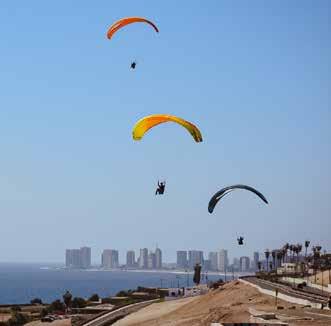

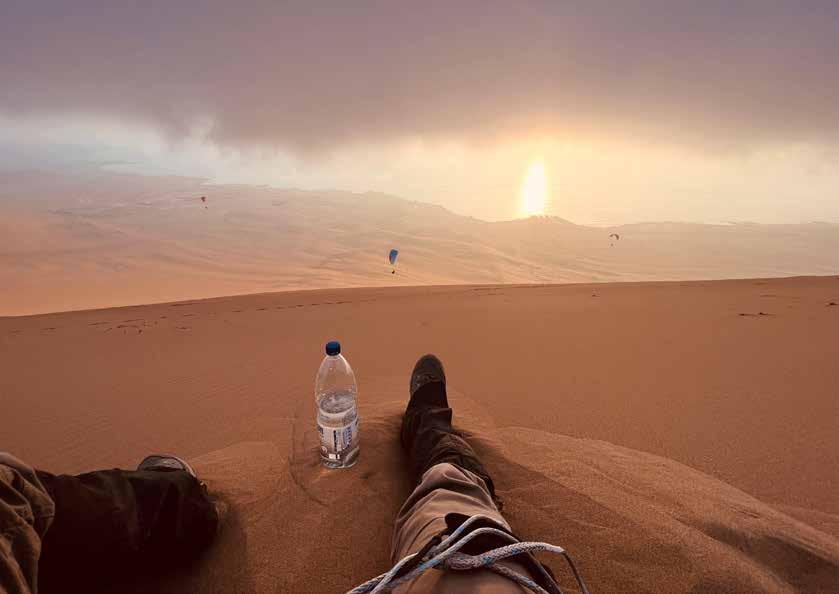
but the inland views enjoy daily gaggles of synthetic butterflies above the morning site, Alto Hospicio. Named after Iquique’s obviously less-prosperous sister city, the city of Alto Hospicio is best described as ramshackle and sprawling. Sitting 2,000 feet higher and less than a mile from Iquique, these two cities are incredibly close yet worlds apart. Neither city can see the other except standing on the very edge of Alto Hospicio; this is where we launch from. To get to launch, you must wind behind Dragon’s
Back, the world’s largest urban dune, which stands nearly 1,300 feet tall at the back of Iquique and is constantly changing. The locals describe shoveling sand after a big storm like we remove snow in Vermont. Behind the dune, switchbacks ascend the barren slope to Alto Hospicio. There are no plants in sight, just rocks, roads, and power lines, plus a depressing speckling of trash and the occasional homeless encampment. Aside from humans, the only signs of life are vultures wheeling above. It’s flyable.
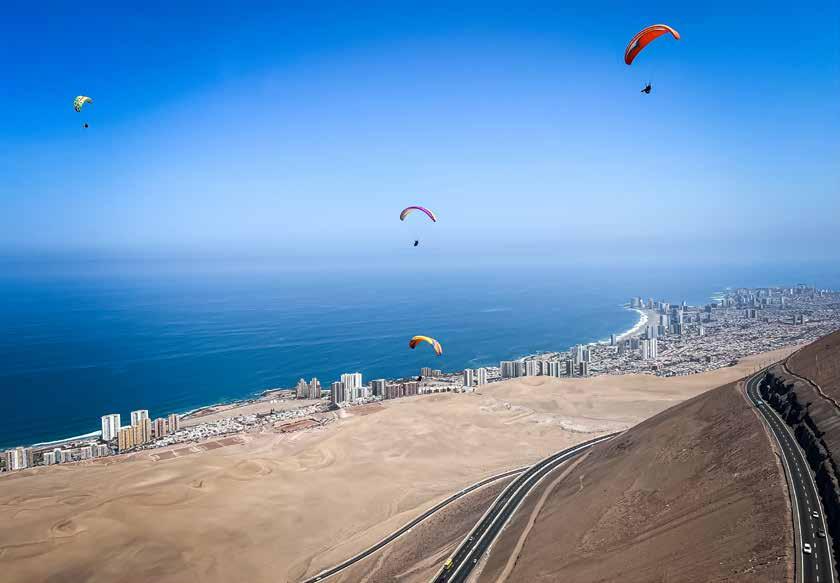
You can take off from almost anywhere on the edge of Alto Hospicio, but you’ll want to pay $1/day to use the official launch, which has large mats to protect fragile fabrics from the harsh rocks and sand. On launch, there’s a lovely little food truck covered in a paragliding mural, and the ocean views are like nothing else, with the beautiful tourist city below guarded or perhaps held captive by the Dragon’s Back. Every morning, the breeze off the Pacific provides. The thermals are mellow and short-lived, with the top of lift typically no more than 1,000 feet over launch, yet the flights can last many hours. It’s possible to strike out on an XC adventure north or south along the coast, but we never had the height or ambition to leave the miles-wide bowl above the city. Having enjoyed the morning flight, we glided out over the ocean and spiraled down, just to move on to the next part of the
daily routine: fresh seafood for lunch, siesta, and then off to the Palo Boque dune, our favorite part of the trip. Fifteen minutes from the city, you’re welcomed to Palo Boque by a large homemade sign missing several letters. The dune is a half mile inland from the coastal road, and AWD feels necessary to avoid an unwelcome adventure of the offroad variety. A narrow track weaves between dumpsters and piles of trash to get to the flying site. Appliances and stained mattresses stand in contrast to the immense natural beauty. The wind carries what it will, blowing the lighter bits of refuse up the dune. One afternoon, I caught a piece of paper tumbling by. The dot matrix printout recorded university test scores from 1984, the year I was born. Most had scored poorly. How and when had these papers joined the wind?
Palo Boque is where ridge soaring meets cross-coun-
(LEFT) Huayaquique beach landing zone offers slow soaring on windy days. Photo by Sarah Robinson. (RIGHT) The author digging deep in the Mystic Dune.
Alto Hospicio launch, looking down on Iquique. Photo by Sarah Robinson.
The author watching the sunset on Mystic Dune.
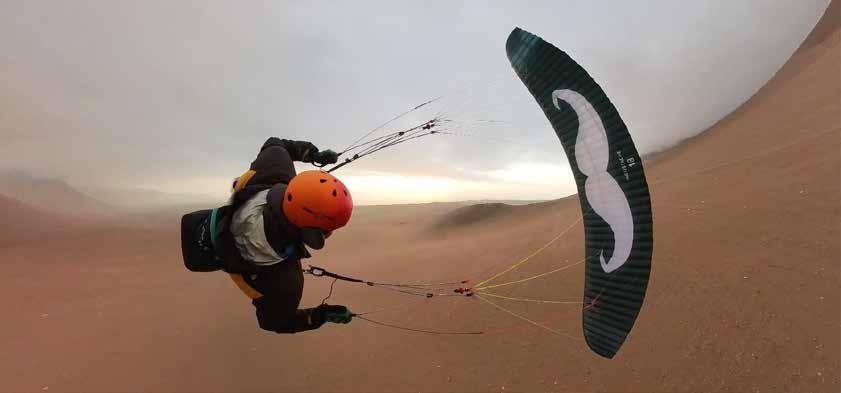
try. Every afternoon, the wind starts strong and thermic and lessens into the evening. The early-launch heroes boom up and out, quickly reaching the top of the ridge, whether they like it or not. Pinned into the wind, the early action is questionably fun. The cautious wait for things to calm, but don’t wait too long as there’s often a relatively short window between comfortable launch conditions and when it’s too calm to bench up. And you want to bench up, as those who make it high on the main dune can reliably soar for 90 minutes longer than those stuck below. If you have options, leave your expensive and/or light-

weight gear at home. Iquique will change you for the better, but your equipment will also be changed, and definitely not for the better. The powdery dust instantly discolors everything it touches, and fine sand infiltrates everything. Snow gaiters proved invaluable for keeping the sand out of shoes.
The FLARE Mustache parakites reigned supreme on the dune. We brought 26, 22, and 18m sizes to share and have options for various wind speeds. The 18m is my favorite for soaring when the wind supports it. It’s a perfect balance of fast with dynamic handling yet remarkably buoyant with higher speed and bet-
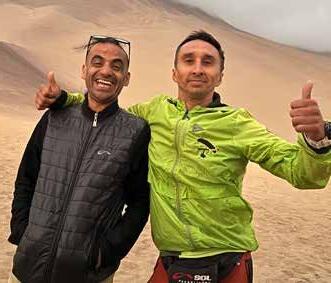
ter glide than most mini wings. More demanding to ground handle and fly than a paraglider, these unique kites offer incredible creativity and three-dimensional freedom. You can float like a paraglider or dive like a speedwing, all controlled with hand position. And the flare power is unbelievable; you can foot-drag for days. Unlike a traditional glider with cells and miniribs that trap sand, the Mustache features an automatic drainage system that constantly evacuates sand and small rocks. The exit holes cannot be closed, so sand comes and goes without worry; this is an all-important feature at the dunes. The same definitely cannot be said for the normal paragliders, which, at best, needed to empty their acquired sand on the hotel lawn every other day.
Tanked up with altitude, our favorite task at Palo Boque was the flight out to Las Dunas Mysticas, where the perfect orange sand is free of rocks and obstructions. The wind sculpts ripples in the sand like waves. It’s a bit of work to get there, but you’ll be rewarded with a “waga” playground like no other. Foot-drag heaven, my daily mission was to paint the dunes with skid

marks that stretched for hundreds of yards so the wind could erode my artwork, leaving only ghost tracks the following day. I recommend sidehill landing high on the Mystic Dune for a snack as the sun goes down and the landscape turns orange. Here, your eyes and mind play tricks on you. Without reference, depth perception and scale become inconceivable. Details become irrelevant; the experience is mystical.
Our trip ended much as it began: paragliding in the morning, then enjoying the day’s catch on the way to the IQQ airport. Iquique had delivered yet again; we’d flown twice a day, every day for eight days straight.
One student earned his P3 on the trip, starting with 13 hours of soaring experience and adding 27 hours, more than tripling his total air time in one week. Iquique isn’t where you’ll gain a mile of elevation in a thermal, it isn’t complex mountains like the Alps, and it certainly doesn’t enjoy grass launches and landings … but you can stack hours like few places, and the strange, unique beauty will blow your mind. And so we said our goodbyes to old and new friends, already dreaming of returning to where the desert meets the sea.
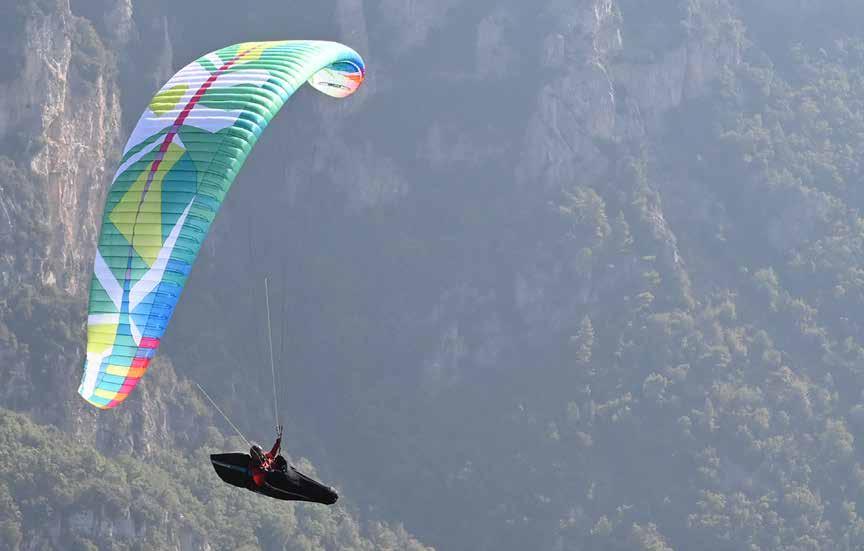
LightweightEN-C
LEAVENOTRACE
HighPerformance2.5Liner
Impressivebrakerange,goodslow-speedbehavior
MoreaccessibleandeasiertoflythantheCURE2
Light,reactiveandprecisehandling
InnovativeSpiralSafetySystem
USHPA PILOT 35 34 USHPA PILOT
Demosavailable: 801-699-1462 info@bgd-usa.com
The author, Calef Letorney, winging it up.
(LEFT) Sea Food Market meal. Photo by Sarah Robinson. (RIGHT) Local drivers/guides Cherry and Latigo. Photo by Calef Letorney.
The World Hang Gliding Championships
by Mick Howard, with a little input from his friends...
2023 U.S. Hang Gliding Team members: John Simon, Pedro Garcia, Robin Hamilton, Willie Dydo, J.D. Guillemette, Mick Howard, Maria Mejia, Jessica Koerner
All of the members of the 2023 U.S. Hang Gliding Team agree that it was an absolute honor to be part of the team; we were all excited to see a mix of new and experienced pilots come together to do our best in representing our country during the Hang Gliding World Championship held in Kruschevo, North Macedonia, last August 6-18. We are grateful for this opportunity and realize it would have never been possible without the very generous support of dozens of individuals and organizations, including but not limited to those who supported our fundraisers (t-shirt sale and Freefunder) and the fantastic Foundation for Free Flight. We also would like to thank Linda Salamone for being our team leader and Jamie Sheldon for her help with various issues.
: Getting to the competition site proved much more complicated than any of us had expected and was quite an adventure. We were traveling from different places across the U.S. and Europe, with half the team flying into Athens, where we landed a day late on August 1. We then had to wait an extra day for our gliders to arrive. Once we collected our gear, we set out for the almost 400-mile drive north to meet the rest of the team in Krushevo.
During the next few days, due to our travel delay, bad weather, and a tailwind on launch, we could not get as many practice days as we had hoped for; even the official practice day was canceled. We only managed a couple of test flights just before the competition. We realized that most teams had been able to arrive a week or more early, as we had tried to do, giving them time
to practice and become acquainted with the topography, flying conditions, and retrieve options. Moreover, the Australians, Brits, and many other teams had a fair amount of experience flying this region—the Pelagonia Valley—during previous competitions, including the two Europen Championships and other major events held there over the years.
Unable to fly, we used the time to work on our equipment and glider racks, which we made out of wooden pallets. We also assembled a front rack for the second vehicle from some parts we picked up in a hardware store (we used toilet plungers as suction cups). We did notice that working on our masterpieces of creative engineering outside the hotel caused a lot of curiosity and interest from the other teams, which is understandable when we compared our retrieve vehicles to those of other teams!
Opening day on August 7 was busy; we had the registration, safety briefing, practice flights, and the opening parade in the evening. The safety briefing was very well organized, professional, and informative. We felt proud to be participating in this event. Thanks to Linda, we were the only team with unique hand-stenciled Team USA polo shirts; otherwise, we wouldn’t have had any uniforms! Other countries had actual team uniforms comprising professionally made shirts and jackets. The main Krushevo launch is an east-facing 4,690-foot MSL mountain site, 10 minutes from the competition headquarters. The terrain is quite rugged despite the appearance from the air, and many potential landing options have to be treated with caution; several fields
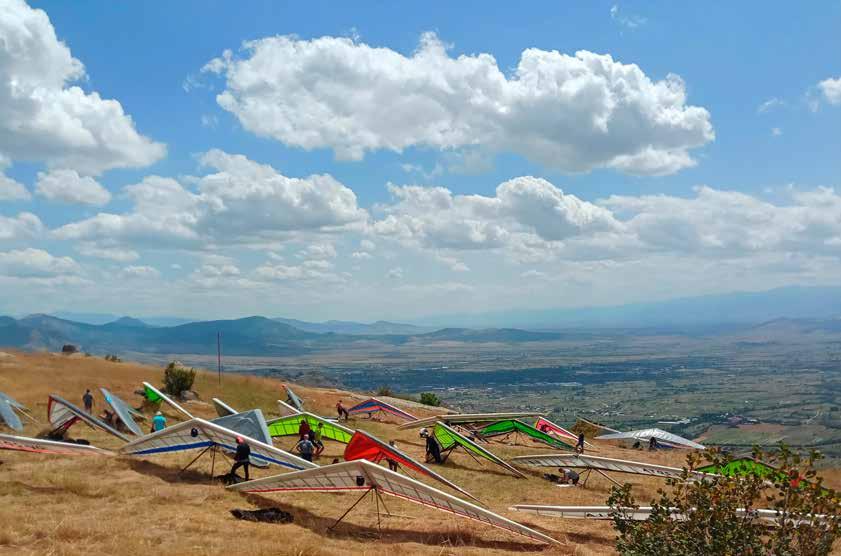
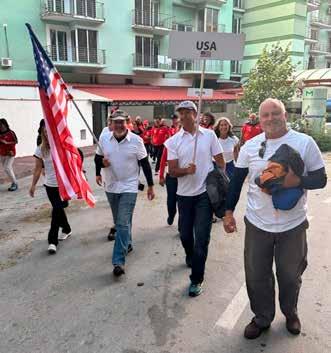
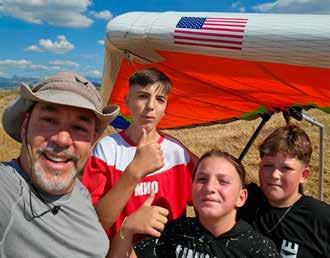
standard vehicle; on top of that, the road network is actually quite limited, and these factors lead to all of us having some long retrieves.
The event
We had a total of nine tasks between August 8 and August 18. Each day, the tasks featured many turn points (several of which were used more than once with different radii) and zigzag lines across the task field; they were often confusing at first. Despite the confusion, the task committee always had a clear explanation and reasoning for each route. The valley winds often made creating a reasonable task a challenge, mainly due to the valley being very good at times and quite weak at others. After each task briefing, we programmed our instruments, held a team meeting, and finished preparing our gear.

are smaller and more restricted than they initially appear due to ditches and gullies that run along them. The direction of hedges and treelines doesn’t always favor the wind direction or ground slope, which is significant in many areas. Also, the ground is quite rutted, rock-hard, and relatively unforgiving. Though there are numerous farm tracks, many are not passable with a
On Task 1, I had a safe, clean launch, but I couldn’t get my feet in the harness as I flew away. At first, I couldn’t figure out why; then I realized the door to the storage compartment in my harness boot had flipped open, and my feet were on the underside of that door, inside the storage compartment boot, preventing me from zipping up my harness. I’ve never had this problem before and never even thought it possible. Yet, there I was, kicking my feet to get the door closed, when I saw my brand new, bright orange helmet bag, my BlueEye goggles, spare lenses, and more, falling away toward the trees below! I fought with my harness for a while but could not fix the problem in flight, so I landed in the bottom LZ in front of launch.
Luckily, Linda was there in a heartbeat and helped me finish packing my glider, loaded my gear up, and got me back up the hill. Everyone had left, including the launch crew, but I was still within the launch window (the launch was still officially open); therefore, I took a relight. (Reviewing my logs later, I saw that from landing to relaunching, my turn-around time was only 1 hour 28 minutes! I certainly wouldn’t have made it without Linda’s very efficient help.) The wind had picked up as forecasted, which made for an easy launch
USHPA PILOT 37
| | | | | | | | | | | | | | | | | | | | | | | | | | COMPETITION
Unofficial practice day at the “Holy Mother of God Monastery” launch on the eastern side of the Pelagonia Valley.
(TOP) The beginning of the opening parade in front of HQ – Hotel Montana. J.D. Guillemette holding the flag, Pedro Garcia holding the U.S. sign and John Simon on the right. Photo by Jamie Sheldon. (BOTTOM) J.D. Guillemette after a happy landing and greeted by some locals.

though with tougher conditions at the start. I tried my best, but after flying just 33km of an 80km task, I ended up finishing fifth of six U.S. pilots for the day. Only the top three scores each day count for each team. Only Pedro made goal for Team USA that day, coming in fifth with only 35 of the 104 pilots who made goal.
Task 2 was canceled after being stopped early. Conditions at launch weren’t ideal; there were some sketchy launches. I believe this was the day a Rigid Wing was carried out of the bushes, and Guy Hubbard (Australian team) blew his launch, sustaining injuries that put him out of the competition.
The launch might have looked great with a long, reasonable-grade slope, but the bushes and trees ahead created a dead zone where gliders lose lift toward the end of the takeoff run. Also, the hill and trees right of launch created some rotor and another dead zone, making launching in the far right lane tricky, especially when there is a southerly wind component. Despite the incidents that morning, some pilots, including me, decided to free fly; we were set up, so why not? I needed the practice, plus we were no longer tied to a launch order, meaning we could wait for the cycle that suited us. It was an enjoyable 2+ hour-long flight south along the mountains.
August 10 was declared a mandatory rest day. The weather was marginal, and there was concern that going up the hill and giving it a try could come back to bite us later in the competition. Category 1 rules dictate one mandatory rest day in a competition. Therefore, if we gave it a try on a marginal day, we could lose out on a day of good flying weather later. We saw this as an opportunity for sightseeing and an early beer!
Task 3 was another day of multiple turn points with huge radii, and not a great day for me as I scored fourth on the team and did not make goal. Pedro, Robin, and John made goal along with 49 others. My landing was tricky with light to no wind, and the field I chose was surrounded by trees reducing my landing area. My retrieve was also a real adventure. What appeared to be a decent farm road was only accessible by a high-clearance or 4WD vehicle. A tractor went by, followed shortly by several children on bikes who came to see what was happening. One of the young girls happened to be an Australian who was staying with her relatives for the summer while her mother and father were back home. She was a great help translating for me, and she and the other kids helped me carry my gear along the road.
Unfortunately, due to the unevenness of the road, my foot slipped down one of the deep ruts in the track while I was carrying my glider, and I went down pretty hard. Though I managed to save my glider from damage, my arm and shoulder took the impact. As I lay there winded and unmoving while I took a minute to compose myself, the kids got pretty worried. From then on, they insisted on carrying the glider for me. The tractor returned hauling another load, but this time the driver stopped. One of the farmers talked with the children, and one of them left on his bike only to return with a beer for me! I then knew that we spoke the same language.
I was certainly glad for their help carrying my glider while I carried my harness, as we had to go through narrow parts and wet areas along the road. I’ve often told pilots that the adventure in hang gliding starts after landing, and this day was a perfect example. I flew for a little over 4 hours and completed 90.9km of the 129.9km task. Though I didn’t score for the team, the memories of this day and these wonderful children will live with me forever!
On Task 4, Pedro and I made goal, so I finally scored for the team (with a 3-hour 36-minute flight)! I made
goal (again with Pedro) on Task 5 and was very pleased to score for the team (with a 4-hour 26-minute flight). On Task 6, only 39 pilots made it to goal, including reliable Pedro, and I was proud to come in second for the U.S., scoring again for our team! I had a good landing but stubbed my toe pretty hard as I touched down on the rock-hard furrows. I thought I had landed a short walk from a track where our retrieve vehicle could reach me, but no such luck. John, JD, and Willy, who had already been picked up, got as close as possible but ended up walking the long trek to help me carry my glider out; I’m so grateful to those guys for that—it was a long and strenuous way. The pain in my foot had me limping, and I was wondering how I would cope with foot launching during the remaining task days. Lucky for me, the task on August 15 was canceled due to the weather, so this became a rest day for my foot.
Task 7 on August 16 was challenging with lots of ups and downs. The air was very unforgiving with broad areas of sink; 800 fpm was not uncommon. With that kind of sink around, it didn’t take long to hit the deck just trying to get to the next climb; we all struggled with the conditions. Pedro did amazing again, making goal and coming in fourth that day. Robin also made it, giving us two U.S. pilots in goal. I came third for our team, landing 17km short on the task. Some 58 pilots did not make goal, which is indicative of the challenge for the day. So far, I was enjoying the event and trying my best to improve. Ibuprofen was doing a good job taming the pain in my foot, so I was able to launch, but
by the time I landed after these long flights, the pain would be back.
Unfortunately, Task 8 on the next day was a total disaster for me! I started out with great intentions of speeding up my game, but after a slow start, I pushed too hard in an attempt to make up time, which put me on the ground by the first turn point. This 2-hour 33-minute flight made me lose several positions. Robin, Pedro, and JD scored for the team, but no one from the U.S. team made goal.
Task 9 was our last competition day. The task was 25km shorter than the previous one, and I was hopeful and feeling more in tune with the conditions; however, I made a big mistake, which I only realized later that evening. Our team did not do great, and JD saved the day by being the only U.S. pilot to make goal. Robin and John were the other two pilots scoring for our team that day.
We had more than the usual mayhem in the start circle with around 60–70 gliders, about half the field (the total was 104 flex wings and 25 rigid), weaving around trying to stay in the same lift. My head was on a swivel, doing my best to avoid collisions, especially since some pilots were flying quite aggressively! Sadly, the aggressive flying escalated as the event progressed, despite several warnings issued by the organizers.
I unknowingly left the start cylinder at 13:02 after meandering around. By leaving, I lost the visual reference of the actual cylinder on my instruments and did not notice as I was just trying to survive in the busy traffic.
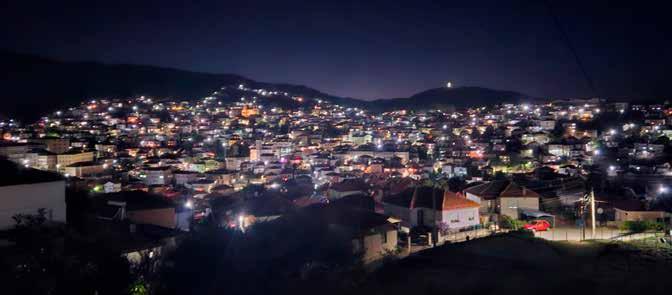
USHPA PILOT 39 38 USHPA PILOT
My glider being dragged out by helpful children after I twisted my foot. The Australian girl who translated is in the black t-shirt. Photo by Mick Howard.
The town of Krushevo at night. Photo by J.D. Guillemette.
The first start was at 13:10, so I had left 8 minutes early! I continued to have my head on a swivel, looking out for other pilots, and when everyone started to leave, I went with them, thinking that we were all still inside the start, not realizing how other pilots clipped the cylinder during their wide turns as they left. I know better, and, in hindsight, I should have paid more attention to my instruments, perhaps even moved away from the gaggle to check my location, but I didn’t. It hadn’t occurred to me that anything was wrong as I went on course, and I found out all this information in retrospect, as it came to light long after I landed. Once tagging the last turn point, I headed north but landed 17km short of goal, which would have placed me third in for the U.S., scoring for the team. A few hours later, I saw an issue with my score. While I had flown 110km of the course and made every turn point, I was only scored for 21.8km. The route made us fly through the start cylinder again, which is when the scoring system validated my start time. It saved me from getting scored Minimum Distance for jumping the gun by more than five minutes.
My poor performance on these last two tasks probably cost me 15 places in the overall score, leaving me finishing 81 out of 104 and 3rd on Team USA.
: During and after the 2023 Worlds, the team talked a lot about how to improve our systems so that future years are smoother and have more support for the team. It was wonderful to have a full team of pilots to discuss and brainstorm ideas leading up to and during the event. We discussed how things went and how we could improve individual and team performance. We aim to make the process easier and more enjoyable for future participants. Some topics that arose were the COVID-19 pandemic isolation impacts on the nature of our flying, the cost of competing, the challenges of traveling with gliders on planes, and finally, the need for early preparation. However, the one thing we all agreed on was how nice it was to share this experience as a group!
We look forward to participating in or watching the U.S. team compete in future Hang Gliding World Championships.

Your expertise as a pilot has earned you exclusive access To Discounts on top brands.
Your involvement with the United States Hang Gliding and Paragliding Association, and your status as an H2, P2 or S2+ rated pilot, have earned you an invitation to join ExpertVoice. It's an exclusive community where you can get deep discounts and insider information from brands like Kelty, La Sportiva, The North Face, Brooks Running, Diamondback Bicycles and many more you know and love. Because brands like these recognize that experts like you know more, do more - and deserve more.
Signing up is simple and free
1. Go to www.ushpa.org/member/ expertvoice-program to sign up.
2. Join the USHPA team.
3. Complete your profile.
4. Enjoy exclusive discounts on top outdoor brands.
USHPA PILOT 41 40 USHPA PILOT
Mid-parade heading towards downtown Krushevo for the opening ceremony. Hand-crafted team shirts by Linda Salamone. Team (left to right): Claudia Mejia (red speedsleeves), John Simon, Linda Salamone (blue jacket), Jessica Koerner (white shoulder bag), Pedro Garcia (grey baseball hat), J.D. Guillemette (brown hat), Robin Hamilton (light blue jeans), Mick Howard (darker jeans, far right). Missing: Willy Dido – busy taking the picture. Photo by Willy Dido.
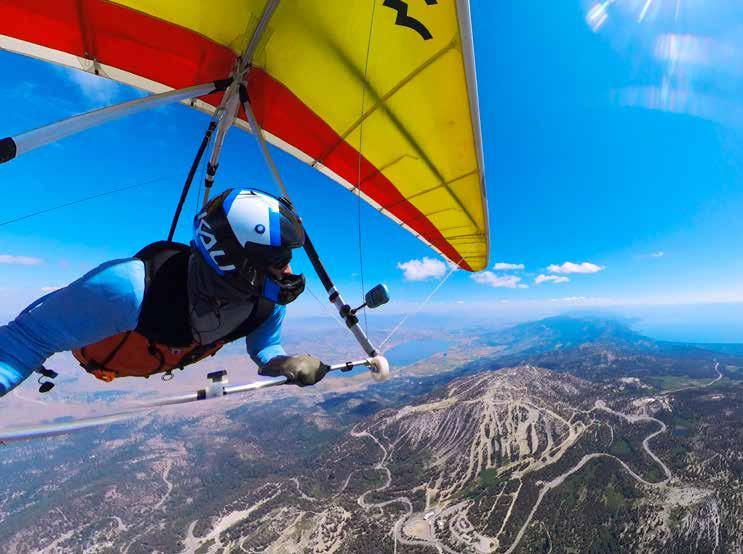
A Weekend at Slide Mountain
: My friend Will Dickey and I decided to head to Slide Mountain near Reno, Nevada, for the weekend of August 5-6, 2023. The forecast looked promising, and the conditions didn’t disappoint! This trip was Will’s first time at Slide, and since Slide is one of my favorite sites, I was excited to introduce him to it.
Slide is located between Lake Tahoe and Reno and sits at the bottom of Tahoe Ski Resort’s Mount Rose. However, Mount Rose is also the name of the mountain about three miles northwest of launch. It’s an unfortunate and, at times, confusing series of names.
As with every site, one should get a proper site intro from a local pilot before attempting to fly here.
by Richard Sibley
Launch is on the side of a winding road that leads to one of the ski lodges at Mount Rose Ski Resort, and the site poses a few unique challenges. First, the road can get sticky in the hot sun, and if you aren’t careful, you can get tar on your gear as you set up. Second, to reach launch, you must climb over a guardrail while wearing your harness and hooked into your glider.
After overcoming the road tar and awkward guardrail straddle, there is just a small flat perch to stand on while waiting for a good launch cycle. The launch faces east into the Washoe Valley and is nice and steep.
From launch, you can see Washoe Lake to the south, New Washoe City across the valley, and the LZ—a
The author enjoying views during a flight from Slide Mountain.
field just beyond Highway 580 with an easy glide of just over 1:4. Paragliders also fly from Slide, but use a different launch further up the road that is a little less steep.
Launching at the bottom of a ski hill at 8,200 feet allows pilots to climb up the ski hill as they thermal from launch. The peak of the ski hill is at about 9,500 feet.
After gaining altitude, a view of Lake Tahoe begins to emerge over the back side of the hill. It is a breathtaking sight as every 360-degree turn reveals a better and better view of the lake!
Some of my highest flights have been at Slide. I’ve been over 14,000 feet many times, 15,000 feet a few times, and once over 16,000 feet. It can get cold at these altitudes, so dressing appropriately is essential, even when it’s hot at launch.
After gaining altitude, you have many options for an incredible flight with amazing views. You can fly over Diamond Peak south of Slide. Heading north, you will fly over the gap where Highway 431 twists and turns from the Washoe area to Incline Village at Lake Tahoe. On the other side of this gap, you can tag Mount Rose peak at 10,700 feet. The site has a lot of XC potential, with flights possible in every direction. I haven’t ventured into those possibilities yet and will let the more experienced pilots in the area elaborate on that topic.
On this particular weekend, Will and I had some great flights. I climbed to 15,000 feet on both days and flew for over six hours. Will got his first two flights at Slide and logged just under four hours of flight time. After such a great weekend, we are excited to get more flying time there soon!
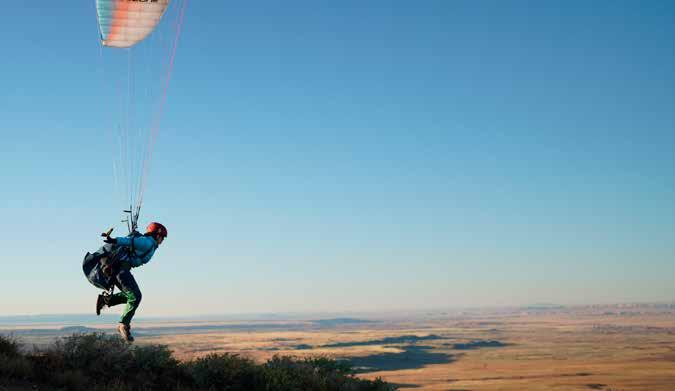
USHPA P2 course available now! This online course fulfills the 8-hour in-person ground school requirement. Spend your valuable time on the hill practicing, not studying! Also includes P2 checklist and flight log tools for tracking your progress, and a student management portal for instructors.
USHPA PILOT 43 42 USHPA PILOT
| | | | | | | | | | | | | | | | | | | | | | | | | | | | | SITES
USHPA is excited to announce a new partnership with Skygear Hub to deliver USHPA training material at glidertraining.org
USHPA will announce new online courses for all wing types, ratings, and skills as they become
BROUGHT TO YOU IN PARTNERSHIP WITH:
New Online training!
available.

The Decentionists
by Scotty "Dobbo" Dobson
: What is speedflying?
The answer to this question is obvious to those of us exposed to free flight. However, outside of our small but growing community, the word speedflying brings forth a magnitude of illusions in which the layperson can get quite imaginative. Is it like that squirrel-suit thing? Where do you jump from? Have you ever done it from El Capitan? Where do you land? We’ve all been in this situation, which can sometimes be overwhelming, especially when you’ve just landed from an exciting flight heartbeats earlier.
In an attempt to escape the questions, I decided to look into making a short film introducing, educating, and advocating for the fringe discipline of paragliding, known to us as speedflying. With no film experience whatsoever, I didn’t know where to start until a local Colorado-based videographer approached me via
Instagram to capture some footage. Upon mentioning to him my desire to create a film, his eyes lit up as he excitedly told me he knew just the guy I needed to talk to.
A real-life “cut to” led to a quick phone call with the to-be director of the film, Edward Clem. With his experience working on multiple ski films and his summer available for new opportunities, Ed was all-in on the idea, and we quickly created a pitch deck to present for potential sponsors.
In January 2022, as I was sitting in Managed Isolation (a.k.a. Hotel Quarantine) for two weeks while entering my home country of New Zealand, I compiled a list of over 300 industry and outdoor-related brands to contact. I sent Instagram messages or emails to each, with about 80 replying with “no” responses and only 12 wanting to hear more about the project. Of these







interested brands, only one company’s marketing contractor was happy to commit actual financial support to the project. In return, we would give them product placement in our film. Plenty of other brands offered products, but at the end of the day, we needed financial support for associated production costs; gear just doesn’t cut it when you have bills to pay.
Our struggle to find funding was understandable when viewed in hindsight. We had a lot riding against us as the economy looked to be tanking, and companies’ annual budgets were already finalized and full. We also had no industry following or proof of concept other than a nicely presented PDF explaining our project’s worth to investors. Fortunately, the one company that got back to us was the global giant Heineken that wanted to spread the word about their new alcohol-free beverage, with the idea being you can still enjoy a malt beverage and perform without the influence of alcohol. With roughly 20% of the estimated production costs now covered, the rest was on me. I had been saving up for no particular reason from bartending while living out of my van, so I had a bit of money to throw at the project, and before I knew it, we were committed to begin filming.
At about this time in March 2022, the entire project changed course when I had an embarrassing and avoidable accident. On a final turn, I banked too close to some trees and had a pretty significant crash, which resulted in several days in the hospital and a severely broken body and busted ego to boot. I spent a lot of time reflecting on the accident and have come to terms with the fact that a combination of complacency and target fixation were out to get me that day. It was humbling and eye-opening. The big overseas objectives of the production now became more-or-less focused on the risks and consequences of the sport. Fortunately, my recovery was quick, and I was able to hike-and-fly before long. That said, climbing anything too strenuous was a little out of my comfort zone for a while longer. Not wanting to give up on working together, Ed and I returned to the drawing board and made a new plan for primary filming involving dates, locations, and a very primitive shot list, all based in my home state of Colorado. Ed, luckily, was a realist in terms of how far money goes in the film industry. I was under a fairytale impression that we could travel somewhere exciting
USHPA PILOT 45 44 USHPA PILOT
| | | | | | | | | | | | | | | | | | | | | | | | | | | FILMS
Descension (noun): An act of moving downwards, dropping, or falling.
with a whole crew, but it was quickly made clear to me that the entire production would have to be filmed in our backyard and on the cheap.
Luckily, Colorado has some fantastic speedflying sites, and we decided to shoot the storyline locally near Breckenridge with the primary-objective scenes in the southwest corner of the state where the autumn colors are world-class. September was the best time of year for weather, and a five-day window in mid-September 2022 was penciled in for on-location filming. There were a few mishaps, including crashed drones, lengthy squalls, and communication issues, but overall, the primary filming went very well. We got what we wanted and within budget, primarily thanks to Ed having his own truck camper from which to rest and charge camera gear. On top of that, we had a passionate FPV drone pilot, Dayne Baumchen (@gr8.dayne), who came along for three days to get the chase shots.
Dayne is a good friend who occasionally comes out to chase us on our routine flights near Breckenridge, and out of pure passion for his hobby, he agreed to help film free of charge. He wouldn’t even let me pay for gas! Without his captivating chase shots, I don’t think there would be a film. Fortunately, he was well-rehearsed in protocols and logistics from chasing us around in other mountainous terrain.
With filming officially wrapped, it was time for the editing process, which was a whole new experience, to say the least. With over a terabyte of footage to sift through, we were in way over our heads. With Ed busy with winter filming and me having zero editing experience, we let our project sit for several months until February 2023, when we recruited a new member to the team to help make sense of the footage. With no idea what speedflying was, Sean O’Brien (@seanob. productions) joined The Descensionists team and made the whole project come to life on screen with his editing genius.
By April, we had a final draft and decided to enter it into any summer film festivals that would accept our submission. Festivals are essentially a marketplace for potential distributors and allow for networking opportunities in the film community. We organized a local premiere night at the bar I worked at in Breckenridge to fundraise for the submission fees and future distribution costs. We had a great turnout. The local flying


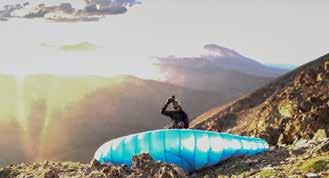

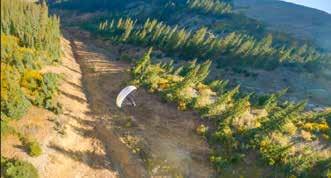
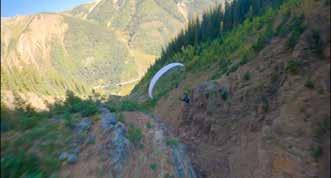

and outdoor community showed up in numbers on an oddly cold June night, where we screened the premiere on an inflatable projector screen and did some giveaways, thanks to local businesses helping out. A huge thanks to Breckenridge Tap House for letting us use their patio and restaurant to hold the event and Northern Standard for their extremely generous gift card donations.
Nothing tangible came of the festivals, but it was a great experience to learn from and be inspired by others’ work. The highlight for me was experiencing the film in its full glory with cinema-level audio and video quality at the Breckenridge Film Festival. It was very well received by other filmmakers who were overwhelmed by the sport and production in general. As a greenhorn in the film industry, I was thrilled to be a part of it all and see other stories told via film.
After some networking, we ended up getting the run-around from a large online distributor for several months. We inevitably decided to go it alone and distribute the film ourselves via YouTube. It had been about a year since primary filming, and we were ready to share the movie with the masses.
It currently has over 250,000 views on our @descensionists channel, which we can’t complain about, but I’m hoping for more views so we can show is achievable with a tiny budget and passion for the sport.
We’re hoping to start the planning stages of a follow-up short film in the coming months, and having The Descensionists as our proof-ofconcept should help find funding for another project. This time, we’ll be more realistic with how far a dollar goes and, more importantly, make safer decisions in my flying pursuits.
It would mean the world to us to have our fellow free flight enthusiasts show some support for the project by watching the film on YouTube: https://www.youtube.com/watch?v=6CvkIOroSJs&t=2s


USHPA PILOT 47 46 USHPA PILOT
Cinematographer Ed Clem in his element, shooting ski films. Winter 2023.

Truth in Advertising
The 2022 and 2023 Texas Go Long Events by Pete Lehmann
I would like to thank Robin Hamilton for his considerable assistance in writing and illustrating this article.
: Over the last three years, hang glider pilots have gathered during the third week of July to attempt long-distance flights from the Wharton, Texas, municipal airport. After modest results in 2021, the event has grown in size and, more importantly, in the miles flown in the subsequent two years. The historic drought conditions of 2022 produced historically good flying, during which the site record was broken several times and numerous personal bests were flown.
The Texas Go Long event is not, strictly speaking, a competition. It is a cross-country fly-in, or to use the historic term associated with the world record-setting Zapata, Texas years, an encampment. The
important distinction is that the Zapata cross-country flying was difficult for various reasons. The few “tourist pilots” who flew there had no XC success whatsoever and some horrible retrieves for their trouble. On the other hand, flying from Wharton is astonishingly safe and easy. Mick Howard, one of the Go Long’s principals, says it is the best cross-country site from which he has ever flown.
As a veteran of Zapata and one who liked to vilify Texas flying, I must concede that Mick is correct.
Flying from Wharton presents pilots of any skill and experience level with smooth, early lift and reliable clouds above flat, open agricultural country with abundant retrieve roads and very few locked gates.
As the day develops, the cloudbase rises from about 4,000 feet AGL to around 7,000 feet—and more on
Setup area at the Go Long event.
the better days. For the less experienced pilots flying lower-performance gliders, there are essentially no barriers to going as far as they want.
For experienced pilots on high-performance gliders, the one limiting factor is the presence of Dallas’ Class B airspace, which begins some 225 miles to the north. Unfortunately, the prevailing summer winds are more or less from the south. As a result, an ambitious XC pilot generally has to make an early route decision: do I want to try to get around Dallas to the east or west? As things turned out during the record 2022 flying, most of the 200+ mile flights took the westerly route, despite the old 241-mile site record having been set along the easterly track.
The Go Long’s Organization
The Go Long is the brainchild of Robin Hamilton and Tiki Mashy and is based out of Tiki’s Cowboy Up flight school located at Wharton’s municipal airport. The genesis of the event was Robin’s observation that the limitations of the Florida competitions
(airspace, trees, wind, locked gates, etc.) had made it very hard for less experienced pilots to enjoy meaningful flights. Realizing that flying from Wharton was far less constrained, he proposed the Go Long idea to Tiki, who agreed to host it.
The airport is situated on the coastal plain roughly 60 miles southwest of Houston and 45 miles inland from the Gulf of Mexico. The proximity to the Gulf is significant as it produces early, albeit low, morning cloud streets that allow early starts to what will be long days. The earliest starts have been before 11 in the morning, with landings at near sunset, around 8:30 p.m.
The towing in both years has been done by a combination of two trikes, Greg Ludwig’s brought in from Florida and Rick Mullins’s from Ohio, along with Tiki’s Dragonfly. Launches were conducted from a mowed grass strip next to the airport’s blacktop runway.
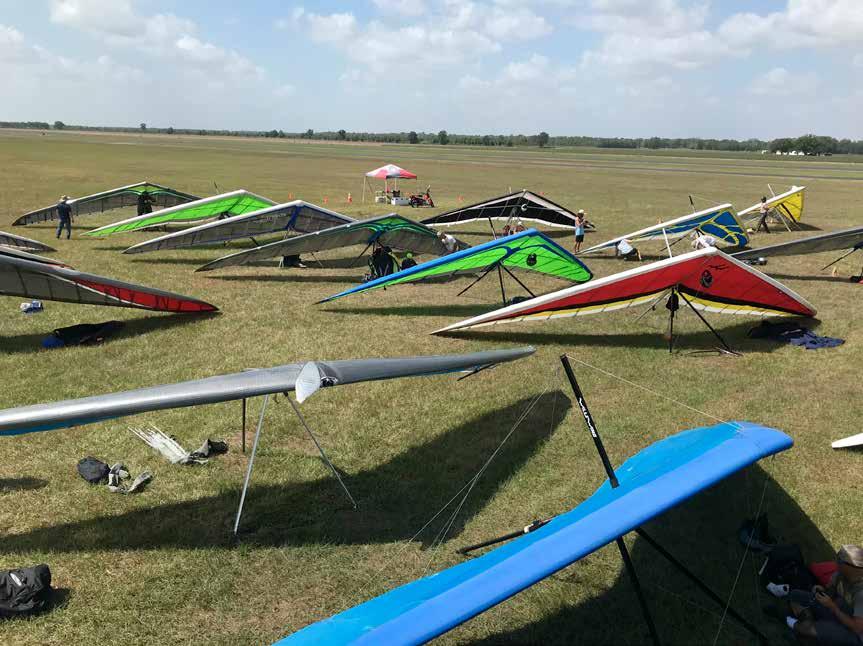
A Typical Day
After setting up, the days began with a pilots’ meeting and weather briefing by Robin Hamilton and
USHPA PILOT 49 48 USHPA PILOT
James Race wins the Icaro Helmet.

sometimes early launches and lowish 3,500-foot cloudbases, relights seldom occurred as the early clouds were numerous, streeted, and reliable. In addition, the tow pilots were good, taking us either to clouds or climbing gliders.
Mick Howard. Both qualify as locals despite having peculiarly British-tinged Texas accents. Robin is a world-class pilot who has been a member of both the British and U.S. world teams. His insights into the weather and its strategic implications for the day’s flying were invaluable. The pilot’s meetings served the additional function of allowing the distribution of daily sponsors’ prizes (Flytec, Wills Wing, Moyes, and Icaro) for meritorious flights and discussion of lessons from the previous day’s flying. In these de-briefs, all commentary was welcome–details from the best flights and miracle vehicle retrieves mixed with smack talk and heckling on the upcoming flying day.
After that, it was first come, first towed; it was often Larry Bunner in his signature lime green attire who was first in line. There was no established launch order. Who was motivated to be first in line was the result of personal ambition, assessment of conditions, and self-confidence. We all wanted to go far, but no one wanted to be the early launcher who decked it only a few miles down the road on an otherwise spectacular day. Don’t ask me how I know. The earliest launchers were often the most experienced pilots present: Larry Bunner, Rich Reinauer, Mick Howard, Robin, and myself. Even with the
Upon leaving the airport’s vicinity, the early part of the day’s flying usually involved carefully following the moist cloud streets and staying as high as possible. If the opportunity presented itself, one would jump the cloud streets to the east or west to position oneself to navigate around the Dallas airspace six hours down the track. We were flying ambitiously. When one had gotten some fifty miles downwind from Wharton and away from the marine-influenced early clouds, conditions would change. The cumulus clouds began to rise higher, but they often became sparser and, initially at least, less reliably strong. I found that transition period to be a bit tricky, requiring us to fly more carefully for an hour or so before the day’s full, drier inland conditions kicked in. After that, it was off to the races on the best days, particularly in 2022. It was genuinely rock’n’roll flying: fast climbs, high bases, and very reliable clouds. The 2023 conditions were, unfortunately, not as good. After the transition, there was only a brief 50-mile period of ever more scattered clouds, which soon dried up. After that, we were flying in blue conditions. Combined with 2023’s lighter tailwinds, our longest flights were nothing like those of the year before.
2022 Record Flying
The highlight of the week’s flying in 2022 was Robin Hamiliton’s site record and JZ trophy-winning 308mile flight to the northwest of Dallas. The flight took slightly over nine hours and got him to 8,600 MSL, nearly 8,000 feet above the ground. To put his flight into context, the site record at the beginning of the week had been his own 241-mile flight from several years prior. During the week’s flying, the original record was broken three times, first by Rich Reinauer, then by Robin himself, and finally by Robin’s 300-miler.
On the day of Robin’s record, Larry Bunner also
narrowly missed breaking the magical 300-mile barrier, landing at 291 miles. While their distances were similar, upon closer inspection, the flights differed considerably in glide ratio (Robin’s 23:1 L/D versus Larry’s 20:1) and average climb rates. Larry’s climb average was 364 fpm to Robin’s 288 fpm, a remarkable difference of 26%, perhaps explained by Robin spending his last two hours working garbage lift to remain aloft and exploit the 20 mph winds. One thing that may have kept Larry from getting as far was getting stuck as he approached the one airspace problem on that track: Waco’s two adjoining Class D airspaces. Robin had skyed to almost 8,000 MSL just at the edge of the airspace and easily crossed over the top. Larry got there low and then squandered precious daylight, struggling to detour around the airspace.
These record flights do not really tell the full story of the Go Long’s success. Altogether, 31 pilots flew in 2022. In addition to the world-class pilots flying high-performance gliders, there were more representative pilots. They ranged from rookies with no XC experience flying single-surface gliders to moderately experienced pilots flying medium-performance king-posted gliders. Categorically, everyone, irrespective of skill level and equipment, had an enjoyable time flying in the Go Long. Twenty-seven personal bests were set, with several pilots doing so more than once. There were 52 flights of over 100

miles and, by my rough count, 16 flights of over 100 miles. Best of all, there were no incidents or accidents. Indeed, other than one retrieve vehicle dying beside the road, there were no nightmarish retrieve stories, something I have always associated with Zapata cross-country flying. The 2022 Go Long was a spectacular success in all respects: excellent tows, safe, smooth conditions, ample LZs, welcoming landowners, and lots of roads for retrieves. I have
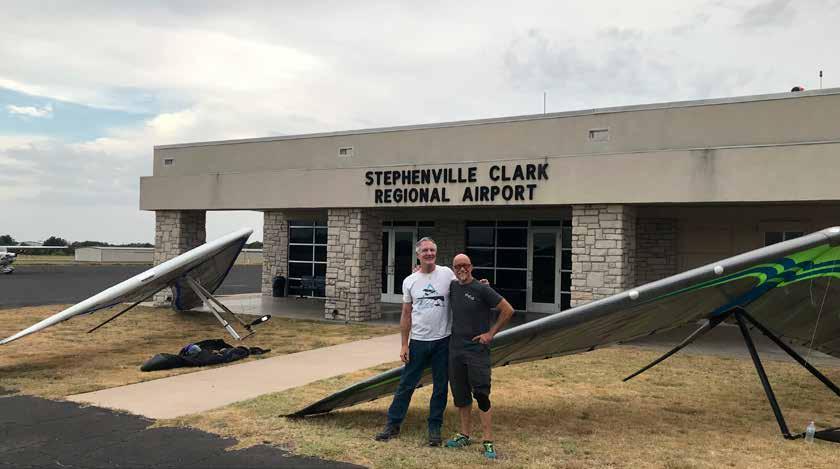
USHPA PILOT 51 50 USHPA PILOT
Larry Bunner's detour around Waco.
Pete Lehmann, John Dawson, and Billy Jack, a Texan land owner.
Larry Bunner and Pete Lehmann after flying together.
flown XC on five continents and have never seen its like. But, lordy, it was hot!
2023 Go Long: Good, But Not Spectacular
Perhaps inevitably, 2023’s flying was not quite up to the previous year’s record standard. That said, the flying was still excellent, except that we could not go as far. The longest flight was Larry Bunner’s 149mile flight to the NNE on a lighter wind day, which became blue for the latter third. In contrast to his excellent flight of the year before, his average climb rate of 155 fpm was less than half what he had seen then. The weaker lift and lighter winds tell much of the 2023 Go Long story. While there were certainly stronger lift days, they usually had light tailwinds and blue conditions once one had left the coastal region.
sizing the benign and extraordinarily reliable conditions. The personal best that stands out is that of John Irlbeck. During 2022, he had set multiple personal bests, but in 2023, he outdid himself by getting 137 miles in just over six hours, the third-longest overall flight. And he did it on a lower performance kingpost U2 glider, and after surviving a 560 feet AGL save along the way. It was an incredible flight.
Go Long 2024
Tiki’s Cowboy Up will again host the Go Long in the latter half of July. If history is any guide, it will provide excellent cross-country flying for pilots of any skill level. Rookies can achieve their first cross-country flights in a setting where everyone attempts the same thing. There is no competition stress, and all pilots behave as friends and mentors. The event is a wonderful opportunity to learn, fly miles, and accumulate hours.
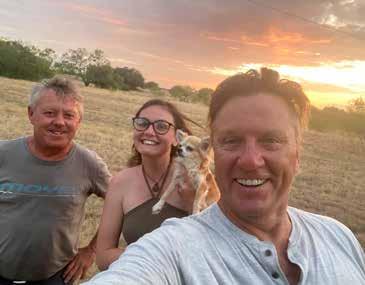

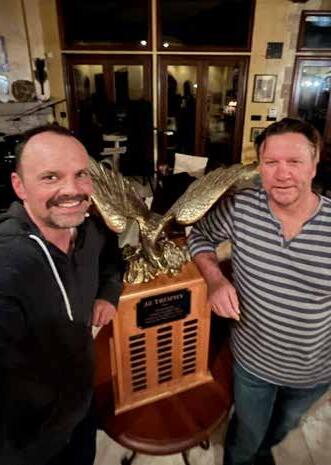
ANNUAL HANG GLIDING JZ XC TROPHY
Since the dawn of hang gliding, the quest for ever longer flights has been at the core of our flying. In the earliest days, the notion of flying a flimsy bamboo or aluminum glider 100 miles was unthinkable. Still, in 1977, the first such flight was flown in California’s Owens Valley by Jerry Katz. Over succeeding years, successively longer flights by Larry Tudor and others pushed the landmark distances past 200 miles in the Owens and then twice past 300 miles, first from Hobbs, New Mexico, and then Rock Springs in southern Wyoming. The first 400-mile flights arrived on the same day in 2001 after the locus of long-distance flying had shifted to Zapata, Texas. South Texas’s remarkable meteorological suitability for long downwind cross-country flights had been discovered by former hang glider pilot and record-holding sailplane pilot Gary Osoba. It was from Zapata that Davis Straub flew 407 miles on a rigid wing on the same day that Manfred Ruhmer flew 435 miles on his Icaro flex wing. Davis’ record endures today, while Manfred’s was unofficially broken by Mike Barber’s 438-miler in 2002. Finally, in 2012, Dustin Martin set the extraordinary 475-mile record that stands today.
Alas, this brief accounting of the highlights of American cross-country flying glosses over the range of wonderful flights accomplished throughout the U.S. over the past 50 years. Wherever pilots have flown, they have sought to extend the local site and regional records.
By now, 50 years on, the attainment of hang gliding record flights has become extremely difficult as world, regional, and site records have all approached their practical limits.
Nonetheless, in an effort to promote and celebrate exceptional cross-country hang glider flights, we are announcing the establishment of the annual James A. Zeiset (JZ) Memorial Trophy. The trophy will be awarded annually on a rotating basis to the U.S. pilot who accomplishes the year’s single longest straight-line flight on a flex wing or rigid wing hang glider.
The enormous award trophy was initially presented to the late Jim Zeiset (JZ) for winning the 1985 Owens Valley Cross Country Hang Gliding Championship. The trophy has been donated by his wife, Amy, and the
trophy will be awarded by Jim Lee (holder of multiple hang glider and sailplane world records) and his wife, Kathy. The trophy consists of a large spread-winged brass eagle sitting atop a 40-inch wooden base, and each year, the name of the pilot who flew the longest cross-country flight for that year will be inscribed on the trophy. The winner will then assume custody of the trophy until the subsequent year’s winner is announced.
To ensure that the year’s best flight is recognized, it is critical that pilots inform Jim Lee by posting them on the XContest website ( https://www.xcontest.org/ world/en/flights/ ). The site is free; one only has to register an account to post IGC files. Alternatively, one can email the files directly to Jim Lee at: leejim17@ yahoo.com
2022 JZ TROPHY FLIGHT: 308 MILES
The winner of the inaugural JZ Memorial Trophy was Robin Hamilton with his exceptional, site-record from Tiki Mashy’s Cowboy Up Flight Park during the 2022 Texas Go Long cross-country event.
Top five flights of 2022
7/23 307.5 Robin Hamilton [Wharton, TX]
7/23 290.9 Larry Bunner [Wharton, TX]
5/16 272.9 Krys Grzyb [Cullom, IL]
7/23 253.42 Rich Reinauer [Wharton, TX]
7/21 238.9 Pete Lehmann [Wharton, TX]
2023 JZ TROPHY FLIGHT: 170 MILES
Wharton flights are usually flown towards the NNW or NNE. 2023 trophy winner Nate Wreyford flew essentially due west for six and a quarter hours, landing just after 6:30 p.m. at Devine, Texas. After releasing from tow, he was never below 4,000 feet AGL while getting to nearly eight grand along the way.
Top five flights of 2023
8/25 169.74 Nate Wreyford [Wharton, TX]
9/20 165.19 Robin Hamilton [Wharton, TX]
7/19 149.55 Larry Bunner [Wharton, TX]
7/19 147.76 Pete Lehmann [Wharton, TX]
7/19 135.58 John Irlbeck [Wharton, TX]
USHPA PILOT 53 52 USHPA PILOT
(TOP) Mick Kaytlin and Robin at the 308 mile LZ. (BOTTOM) Robin celebrating at 308-miles, post landing.
2022 and 2023 JZ Trophy winners Nate and Robin
Fly-in with a Mission
20 years of the Northern California XC League
by Jugdeep Aggarwal
Highlights from the last 20 years
• It is always a thrill to see pilots (and the total joy on their faces) make goal for the first time, especially when they have been chasing the reward for years; for example, Jay coming into Stonyford goal.
• Who can remember getting pizza delivered to St. Nick’s while we cooled off in the pool after a hot day of flying?
It’s interesting to go back over the years and see how the league has evolved. Here are some of the highlights and changes I’ve seen over the years:
: The league has evolved over the years. For some events, attendance at Potato Hill was as low as three (me, Tom, and Gregg) and up to 42 with no space to put all the pilots, let alone lay out gliders. There were
: The Northern California Cross Country League has been running for over 20 years, and I took the reins in 2004 from Jorge Ewald when he left for Switzerland. I arrived in the U.S. in January 2003 and was blown away by the frequency of the weekend fly-ins punctuated by the league’s low-key, friendly competitions. I was instantly hooked by the 20km tasks at the league’s local sites: Potato Hill, Dunlap, and Tollhouse. When the opportunity came up to take over the league, I jumped at the chance. Rather than putting on a race-to-goal event, my emphasis for the league has been more of a “fly-in with a mission” to encourage non-racing pilots to attend, along with those who want to fly with friends and know there is a retrieve at the end of the day. Running the league has involved developing the risk management plan, organizing event insurance, managing pilot registration, ensuring enough vehicles and drivers for each event, managing pilot checkin and check-out, and scoring the tasks. It’s been a ton of work but incredibly rewarding.

• Dozens of pilots (47 in all!) at Paiute in the Owens Valley for a 75km task to Independence.
• The thrill of running a task at a new site (Whaleback) and seeing the pilots’ excitement about the possibilities.
• The joy of a task out of McLellan where we launched and hit cloudbase at 16,000 feet within 15 minutes and then had a downwind task along a cloud street with a tailwind. Peter S. won the 55km task in 40 minutes.
• Let’s not forget Darren’s unplanned overnight stay in the triangle of despair at Potato Hill and the epic walk dragging his glider under the dense bush.
• It was fun to watch tandems racing into goal at Tollhouse with a photo finish
• Running tasks at Owens Valley in 2004
• Running tasks at Woodrat in 2005
• Use of GAP scoring in 2006
• Running tasks at Whaleback in 2011
• Printed sign-in sheets in 2012
• Dedicated drivers and retrieve vehicles in 2014
• Start of Sprint league for junior pilots in 2014
• Start of a buddy system for tracking pilots in 2014

• Video of the league in 2015
• Running tasks at Tahoe in 2015
• Use of XCDemon for registration and scoring in 2016
• Formalized insurance through USHPA and ACE Insurance Program in 2017
USHPA PILOT 55
54 USHPA PILOT
| | | | | | | | | | | | | | | | | | | | | | | | | | | COMPETITION
Launch in the Owens. Task briefing before launchign the Owens.
even events that attracted pilots from Seattle, Hawaii, Colorado, and Alaska. It’s been interesting to reflect on how task distances have increased from a modest 25km in the early years to over 80km now, demonstrating the improvement in our understanding of flyable routes, improved glider performance, and improved pilot skills.
Most Memorable Pilots
JoshNEric, Frank the tank, Broyhill, Bad Pat, Good Pat, Tom, Steve, Fred, Fabian, TimO, William, Reavis, Mitch, Pocket, Susan, Benanna, Doug, Aaron, Dean, Alex, Natalia, Ross, Martin, Jon, Stephan, Gregg, Peter S., Darren, JK, Mike, Bob, Nova, Roger, Beezee, Ron, Dietmar, Robin, Debbie, Kurt, Tyler, Alex, Guido, Jack, Zane, Jay, Tristan, Ismo, Chris, Jeff, Omar, Clem, SOB, Rick, Kansas, Chuck, and I’m sure I have missed a few.
It has been a thrill to fly with you all.
No matter how things have changed over the last 20 years, watching (and participating in) each event with a throng of friends is always exciting. It is not just the evolution of the league that is notable, but also the growth of pilots themselves. I feel honored to have watched fledgling pilots, including Reavis Sutphin-Gray and Mitch Riley, have their early flights with the league and then progress to almost unimaginable levels. I’d like to know that I’ve been influential in their flying careers and given them an opportunity to grow. Who knows who our next prodigies will be and if they will cut their teeth at the league? On top of that, we have been lucky to have only a handful of incidents over the past 20 years. Let’s keep it that way! Numerous sponsors have generously supported the league over the years, including USHPA, Foundation for Free Flight, BAPA, Eagle, SuperFly, Flytec, Free Flight Research Labs, Cross Country Magazine, and currently Flymaster USA. Without these sponsors, the league would not have continued over the years. Thanks to all who have supported the league.
What does the next 20 years look like?
It would have been difficult to guess 20 years ago what the league would look like today—with the number of participants, the sites we fly at, and the two different leagues. Looking to the future, the challenges of increasing insurance costs for organized events pose some risks, as does the lack of engage-

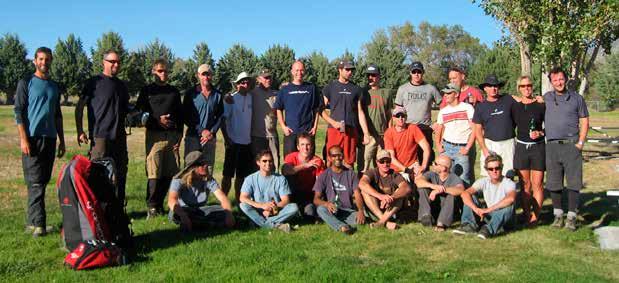
ment of the more experienced pilots. However, with the continual feed of junior pilots from Lift Paragliding, Penguin Paragliding, Lake Tahoe Paragliding, and Airtimes of San Francisco, I am confident we can keep the leagues running.
So, what was the 2023 season like?
2023 saw a late start to the season with the abundance of rain and snow closing many launches. The
storms even wiped out road access to Potato Hill for the whole season. Despite this, there was phenomenal attendance at the Sprint kick-off at Tollhouse, with over 40 pilots, including many newbies. Attendance remained high throughout the season, even into October, with nine tasks flown.
The XC league has not faired as well, with only three tasks for the season due to poorly timed weather and below-threshold attendance. Since Sprint leagues are
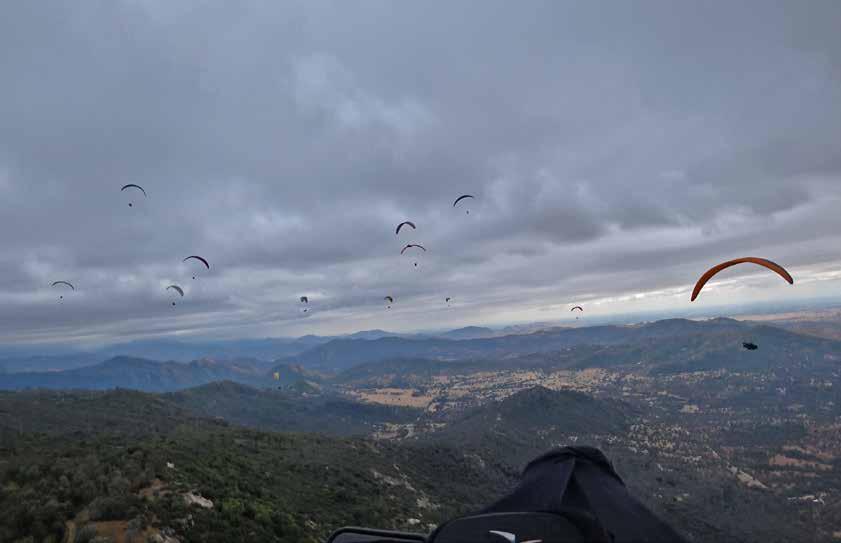
USHPA PILOT 57
XC
in the
on Paiute Launch.
pilots
Owens Valley
Pilots in goal in the Owens. Pilots flying Tollhouse.

XC league Cat 1 (EN-D and below)
First place
Jugdeep Aggarwal
Second place
Dmitrii Khairullin
Third place
Doug DeGeorge
2023 Winners
XC league Cat 2 (EN-C and below)
First place
Jugdeep Aggarwal
Second place
Dmitrii Khairullin
Third place
Doug DeGeorge
Cat 3 Sprint League (EN-B and below)
First place
Doug Anawalt
Second place
George Du
Third place
Doug DeGeorge
fishbowl-type tasks, there is little scope for a variety of tasks. On the other hand, the XC league had some new routes out of Tollhouse to pass Dunlap and one task from Dunlap way past our usual goal of Woodlake. It’s always nice to go somewhere new.
Congrats to winners, congrats to those who made it for the first time, and even more congrats to those who went out of their comfort zone and went a little further, higher, and longer than they have before. Well done all. I look forward to seeing you all next season.

Reflections from League pilots over the years
Dodam Ih I am a relatively new pilot who has been “chasing it” pretty hard, and Sprint League has been extremely beneficial to my progression. It’s a great way to get an organized site introduction for flying at an unfamiliar site, as well as meet other pilots, both newer and more experienced. I’ve heard from many successful pilots how important continued mentorship past P2 is, and Sprint League has a lot of mentorship. So much of the knowledge in our sport is gained through osmosis, and I’ve learned a lot from just spending time with other pilots in addition to the task discussions and debriefs.
Brad Bass I met Jug on June 12, 2005, at Tollhouse, California, when I was looking for a site orientation, and he and his XC league were looking for help getting up to launch in my truck. Within a couple of years, I became a regular participant and remain one to this day. I was initially attracted to the community of expert pilot participants (many of whom became my unofficial mentors and close friends) and the prospect of developing the skills and flying XC in amazing places. These days, I make goal more often than not and never regret any humbling experience of landing early. Many new participants assume the XC league is going to be some testosterone fest with pilots pushing each other into risky situations. I’ve found this is not the group culture. Most participants quickly accept that the task of the day is just an opportunity to practice thermaling, gaggling, and making good decisions to either stay up along the course or land safely in sometimes very weird places. I’m grateful for the XC
league—if it weren’t for the community and challenges offered by the league, I would have likely drifted away from this sport years ago.
Susan Kent It seems in a blink of an eye that the NorCal Paragliding League started over 20 years ago, first as a fun get-together, then as a more organized event. At first, we did shorter, local valley tasks, but as the league’s popularity increased and drew more experienced pilots, the task lengths increased. Experienced pilots were encouraged to mentor lower airtime pilots, and there were discussions on the best ways to do the tasks.
There were also specific classes so lower-rated wings weren’t competing with comp and D-wing pilots. But the longer tasks were still psychologically overwhelming, even competing in your own wing class.
As the league became more popular, it became apparent that lower airtime pilots needed more specific mentoring and tasks. To fill the needs of very experienced pilots and brandnew XC pilots simultaneously, two leagues were created: the NorCal XC League for the big guns and the Sprint League with shorter tasks and much more mentoring.
The Sprint League turned out to be extremely popular, and participation soared. With more detailed mentoring and shorter tasks, it was a valuable learning experience on everything from gaggling etiquette, thermal triggers, route planning, strategies for flying the task, and more. Besides the joys of learning and going XC, the fun part was always the celebrations, debriefs, and refreshments afterward. Kudos to Jug for all his efforts and running the leagues over the years.
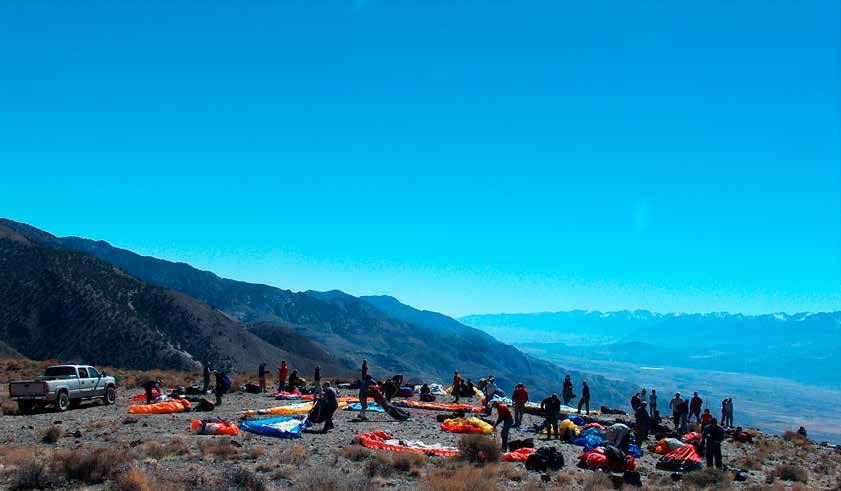
USHPA PILOT 59
Setting up on Pauite launch.
BUYERS SHOULD SELECT EQUIPMENT THAT IS APPROPRIATE FOR THEIR SKILL LEVEL OR RATING. NEW PILOTS SHOULD SEEK PROFESSIONAL INSTRUCTION FROM A USHPA CERTIFIED INSTRUCTOR.
USED HANG GLIDERS should always be disassembled before flying for the first time and inspected carefully for fatigued, bent or dented downtubes, ruined bushings, bent bolts (especially the heart bolt), re-used Nyloc nuts, loose thimbles, frayed or rusted cables, tangs with non-circular holes, and on flex wings, sails badly torn or torn loose from their anchor points front and back on the keel and leading edges. USED PARAGLIDERS should always be thoroughly inspected before flying for the first time. Annual inspections on paragliders should include sailcloth strength tests. A porosity check isn't sufficient. Some gliders pass porosity yet have very weak sailcloth. If in doubt, many hang gliding and paragliding businesses will be happy to give an objective opinion on the condition of equipment you bring them to inspect.
BUYER BEWARE.
CALENDAR
The event calendar shows all USHPA-sponsored events including sanctioned competitions, ACE events, board meetings and instructor, admin, or towing cliniccs. For student cliinics, tours, fly-ins, and more check the Classified listings.
* Sanctioned events pending approval.
* MAY 17-29 > USHPA TANDEM 1 AND TANDEM INSTRUCTOR COURSE Sunset Beach, Oregon. Tandem flight is one of the most amazing things you can do in a paraglider, but it also is a tremendous responsibility as you are literally taking someone else’s life and good health into your own hands.
Let us help you gain the confidence and skills to become the best tandem instructor you can be!
Contact us for full explanation of our training sequence and any pre-requisites. https://www.discoverparagliding.com/instructor_training/
MAY 24-26 > BASIC/ADVANCED INSTRUCTOR COURSE Sunset Beach, Warrenton, Oregon. Our three-part USHPA certified Instructor Training Program (ITP) is designed to teach you how to work with the dynamic range of students you might encounter. After your initial three-day clinic, we can assist you during your apprenticeship period, followed by a two-day Instructor Evaluation Clinic where you can earn your Basic Instructor Appointment. Advanced Instructor Candidates and renewals will participate in a two day training/evaluation course. Contact us for more details. https://www.discoverparagliding.com/instructor_training/
MAY 28 > USHPA REMOTE BOARD MEETING
The meeting will be held online via a Zoom conference call at 6 p.m. (MT), and all members are invited to attend (remember to register by the deadline). Many members have expressed an interest in better understanding how USHPA operates, who makes decisions, and the organization’s financial picture. Come to a board meeting and find out! Registration deadline: May 27, 2024 at 5 p.m. (MT); registration link: https://www.ushpa.org/page/online-board-meeting
* JUN 16-21 > OZONE CHELAN OPEN 2024 > The Ozone Chelan Open 2024 will be an EN-C and lower event where XC pilots new to competitions get to race alongside and learn from some of the best pilots in the world. The competition will follow the same format as other FAI Cat 2 events and include daily briefings lead by U.S. National Champion and Ozone team pilot Nick Greece. These briefings will include analysis of previous days tasks, XC flying techniques, racing strategies, understanding the local weather and micro-meteorology and how to have fun, fly safe, and make goal. Nick Greece will be assisted by other top U.S. paragliding pilots. www.airtribune.com
* JUN 23-29 > U.S. OPEN OF PARAGLIDING 2024 > The U.S. Open of Paragliding will be a Cat 2 Race-to-Goal USHPA sanctioned XC competition held in Chelan this coming June. Registration opens February 1st at 7p.m. (PT). www.airtribune.com
JUL 30 > USHPA REMOTE BOARD MEETING The meeting will be held online via a Zoom conference call at 6 p.m. (MT), and all members are invited to attend (remember to register by the deadline). Many members have expressed an interest in better understanding how USHPA operates, who makes decisions, and the organization’s financial picture. Come to a board meeting and find out! Registration deadline: July 2, 2024 at 5 p.m. (MT); registration link: https://www.ushpa.org/page/online-board-meeting
* JUL 3-8 > APPLEGATE OPEN 2024 > The Applegate Open consists of two races. A sanctioned race-to-goal "Open" race for EN-C gliders and above and a non-sanctioned "Sprint" race-to-goal for EN-B and EN-C gliders. Registration will be limited to 140 gliders total for the two events. www.wingsoverapplegate.org
* SEP 1-6 > RED ROCKS WIDE OPEN > Reliable weather. Big Air. Bigger vistas. Five launches that take different wind directions. HUGE XC potential through some of Utah’s most incredible natural wonders. Welcome to the Red Rocks Wide Open! This is a USHPA National Championship series Cat 2 event that promises strong conditions and long tasks that take advantage of deep, tall mountain ranges and high-desert flatlands. Participants should be very comfortable with flying in strong thermals at high altitudes. Oxygen is highly recommended (tank refills will be available for $10 each during the comp and practice day). Systems are available to buy and rent. Garmin InReach or other satellite tracker with messaging capability is mandatory. https://www.usparaglidingcompetitions.com/red-rocks-wide-open/
SEP 24 > USHPA REMOTE BOARD MEETING The meeting will be held online via a Zoom conference call at 6 p.m. (MT), and all members are invited to attend (remember to register by the deadline). Many members have expressed an interest in better understanding how USHPA operates, who makes decisions, and the organization’s financial picture. Come to a board meeting and find out! Registration deadline: September 23, 2024 at 5 p.m. (MT); registration link: https://www.ushpa.org/page/online-board-meeting
CLASSIFIED
Rates start at $10.00 for up to 200 characters. ALL CLASSIFIEDS ARE PREPAID. No refunds given for cancellations. More info: ushpa.org/page/ magazine-classified-advertising
HAWAII > PARAGLIDE MAUI > Call Paul Gurrieri for information about flying on Maui. Our school offers beginner to advanced instruction, year round. It takes 10-14 days to get your P2 license. +1 808.874.5433 paraglidemaui.com
NORTH CAROLINA > KITTY HAWK KITES > The largest hang gliding school in the world, teaching since 1974. Learn to hang glide on the east coast's largest sand dune. Yearround instruction, foot launch, and tandem aerotow. 1902 Wright Glider Experience available. Dealer for Moyes, Wills Wing, and North Wing. Learn to fly where the Wright Brothers flew, located at the beach on NC's historic Outer Banks. Also visit our NH location, Morningside Flight Park. +1 252.441.2426, +1 877.FLY.THIS, kittyhawk.com/ hang-gliding
NEW HAMPSHIRE > MORNINGSIDE > A Kitty Hawk Kites flight park. The northeast's premier hang gliding and paragliding training center, teaching since 1974. Hang gliding foot launch and tandem aerotow training. Paragliding foot launch and tandem training. Powered paragliding instruction. Dealer for Moyes, Wills Wing, and North Wing. Located in Charlestown, NH. Also visit our North Carolina location, Kitty Hawk Kites Flight School. +1 603.542.4416, www.flymorningside.com
VIRGINIA > BLUE SKY > Full-time, year-round hang gliding instruction, scooter towing, platform towing, powered harnesses, part-time aero towing, part-time paragliding, custom sewing. Wills Wing, Moyes, Icaro, Swedish Aerosport, Woody Valley, +1 804.241.4324, www.blueskyhg.com
NEED TO IMPROVE YOUR WING CONTROL? Kiting is the key! Join Andre Bandarra in person or online - for expert tips to improve your safety and confidence. Reserve your place for Spring 2024, or sign up today for free at andrebandarra.com/retreats
PARACRANE TOURS 2024 > Paracranetours 2024. Veteran guide Nick Crane leads paragliding tours and spectacular flying in the tropics of Costa Rica in February and the Alps of Europe in September! Small groups allow maximum flexibility to fly the best sites in the best conditions. Pilots and non-flyers love our tours! www.paracranetours. com nick@paracrane.com
THERMAL/WINGLISTICS CLINIC > May 3-5, 2024 - $650 Thermaling efficiency. Reading terrain features for thermal triggers and reservoirs. Reading & understanding cumulus cloud formations & what they tell us about the type of thermals that are feeding the cloud types that may not be necessarily advantageous for thermalling. How to “work” cloud base. The best launching & landing techniques to use during thermic conditions. Learn your wing’s language and more... Contact Ken at Twocanfly@gmail.com
THERMAL/WINGLISTICS CLINIC > June 7-9, 2024 - $650 Thermaling efficiency. Reading terrain features for thermal triggers and reservoirs. Reading and understanding cumulus cloud formations and what they tell us about the type of thermals that are feeding the cloud types that may not be necessarily advantageous for thermalling. How to “work” cloud base. The best launching and landing techniques to use during thermic conditions. Learn your wing’s language and more...Contact Ken at Twocanfly@gmail.com

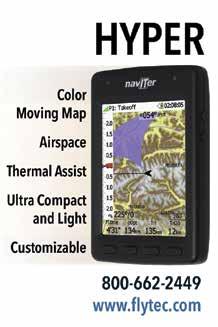

60 USHPA PILOT

H1 5 Craig Markyvech MI Dalton Burkhalter
H1 5 Timothy Marlett NY Daniel C. Guido
H1 5 Michael Sepate OH William G. Vaughn
H1 5 Akshay Sood NY William G. Vaughn
H2 1 Ethan Kunz OR James W. Tibbs
H2 1 John Spillman OR James W. Tibbs
H2 2 Jesse Martin CA George Hamilton
H2 3 Lance Ashworth AZ John Heiney
H2 3 Micah Jackson CA Adam Smith
H2 3 Kimberly Wright CA Andrew T. Beem
H2 4 William Troy Britt TN Gordon Cayce
H2 4 Jolene Creighton FL Gordon Cayce
H2 4 Walter Dec FL Malcolm A. Jones
H2 4 Moses Ezekiel FL Derreck Turner
H2 4 Joey Savitsky NC Billy B. Vaughn
H2 5 Brent Bumgardner IN Dalton Burkhalter
H2 5 Michael Corum IN Scott Schneider
H2 5 Peter Cozzolino IN Derreck Turner
H2 5 Ivan Duma NY Bryon Estes
H2 5 Nathaniel Gill MD Steve A. Wendt
H2 5 Christopher Ruscher IL Dalton Burkhalter
H2 5 Sherif Tadros NJ Bryon Estes
H3 2 Richard Beadle CA Richard Sibley
H3 4 Efrain Garza TX Tiki Mashy
H3 4 Mie Greenberg NC Gordon Cayce
H4 2 Chris W. Santacroce UT Mel Glantz
H4 3 Ronald Andrade-Mckeehan CA Lj Omara
H4 3 Peter Meinhold CA William C. Dydo
H4 5 Mark Dowsett NY Robert Skinner
P0 3 Benjamin Cook CA Jay Whiteaker
P0 3 Lora Cook CA Jay Whiteaker
P0 3 Derek Dernbach CA Jay Whiteaker
P0 3 Sai Harsha Jandhyala CA Jay Whiteaker
P1 1 Jason Giddings ID Jordan Neidinger
P1 1 Seth Marsh OR Nate Scott
P1 2 Mary Turpin NV Jordan Neidinger
P1 2 Xiaochen Zhou CA Jeffrey J. Greenbaum
P1 3 Lance Alder CA Emily Wallace
P1 3 Charles Callender CA Jay Whiteaker
P1 3 Jimmy Capra CO Gregory Kelley
P1 3 Jonathan Dawang CA Jordan Neidinger
P1 3 Darryl File CA Jay Whiteaker
P1 3 Zachary Heiland AZ Chandler Papas
P1 3 Jeremiah Heilig CO Chris W. Santacroce
P1 3 James Mauerman CA Emily Wallace
P1 3 John Rowell CA Jeffrey J. Greenbaum
P1 4 Scott Iverson MO Richard Mcdermott
P1 5 Danial Eastman IL Ian Mcmanus
P1 5 Lisa Haswell NH William H. Gottling
P1 5 Nick Laroche MA William H. Gottling
P1 5 Jonathon Shockley NJ Joe D. Hutton
P1 5 Lindsay Stevens WI Mariyan Radev Ivanov
P2 1 Farshad Allahdadi OR Kelly A. Kellar
P2 1 Jaison Ashbaugh MT Nathan Alex Taylor
P2 1 Trystan Butcher MT Ernesto Martinez
P2 1 Gregory Chema MT Jennifer Bedell
P2 1 Jackson Dove WA Denise Reed
P2 1 Samantha Feemster AK Nathan Alex Taylor
P2 1 Oceana Gamel Howes AK Nathan Alex Taylor
P2 1 Robert Glasson WY Andy Macrae
P2 1 Christopher Graham ID Nathan Alex Taylor
P2 1 Nikko James AK Patrick Kelly
P2 1 Christopher Jewell MT Andy Macrae
2 Navid Afsarifard CA Robert Black
P2 2 Amy Betcher UT Stacy Whitmore
P2 2 Lisa Bredenkamp CA
USHPA PILOT 63 62 USHPA PILOT RTG RGN NAME STATE RATING OFFICIAL RTG RGN NAME STATE RATING OFFICIAL P2 1 Patrick Liddell MT Ernesto Martinez P2 1 Matt Lloyd MT Andy Macrae P2 1 Aaron Loyd OR Kelly A. Kellar P2 1 Jazmyn Maire MT Joshua Phillips P2 1 David Meyers MT Jonathan Jefferies P2 1 Deanna Molenda WA Denise Reed P2 1 Thomas Montague WA Matt Senior P2 1 Garrett O'briewn WA Christopher Gulden P2 1 Carter Olson MT Andy Macrae P2 1 Ian Palmgren WA Chad Uchino P2 1 Yashwant Parikh WA Matt Senior P2 1 Landon Paschall ID Gregory Kelley P2 1 Sureshkumar Rangasamy AK Rob Sporrer P2 1 Ryan Ried OR Kimberly Phinney P2 1 Alex Schubert OR Kelly A. Kellar P2 1 Justin Scorza HI Pete Michelmore P2 1 Edward Steinhauer OR Kelly A. Kellar P2 1 Jack Swanson MN Mariyan Radev Ivanov P2 1 Arielle Todd WA Chad Uchino P2 1 Christian Warren OR Harry Sandoval P2 1 Joshua Weidinger OR Kelly A. Kellar P2 1 Rick White OR Maren Ludwig P2 1 Gabriel Wicke WA Patrick Kelly P2 1 Bradley Yates WY Scott C. Harris P2 2 Braidon Adams UT Stephen J. Mayer P2
Robert Black
P2 2 Alexander Faber CA Robert Black P2 2 Jacquelyn Fu CA David Oddy P2 2 Kevin Gibelyou UT Patrick Kelly P2 2 Andrew Gilligan CA Robert Black P2 2 Jake Gilmore UT Jonathan Jefferies P2 2 Sean Glang CA Jeffrey J. Greenbaum P2 2 Abhijeet Gole CA Jeffrey J. Greenbaum P2 2 Nathan Greer CA Robert Black P2 2 Brixton Hakes UT Jonathan Jefferies P2 2 Whitney Holcomb UT Christopher Grantham P2 2 Feridoon Ibrahimi CA Jeffrey J. Greenbaum P2 2 Xiyu Kang CA Jeffrey J. Greenbaum P2 2 Miranda Kang CA Jesse L. Meyer P2 2 Johnathan Lomas NV Mitchell B. Neary P2 2 Anthony Mcdonald UT Stacy Whitmore P2 2 Rithvik Narayan CA Jesse L. Meyer P2 2 Matti Oikarinen CA Jeffrey J. Greenbaum P2 2 Daniil Oxyuk UT Stephen J. Mayer P2 2 David Price UT Nathan Alex Taylor P2 2 Mandeep Sandhu CA Robert Black P2 2 Scott Smith UT Nathan Alex Taylor P2 2 Jeremy Spiegel CA Robert Black P2 2 Angela Stroman CA Robert Black P2 2 Diana Sy CA Jeffrey J. Greenbaum P2 2 Dan Thomas UT Jonathan Jefferies P2 2 Rodolfo Thumann CA David Oddy P2 2 Chance Tiner UT Patrick Kelly P2 2 Nicholas Tombari CA Robert Black P2 2 James Tropp CA Jesse L. Meyer P2 2 Joe Vitale UT Patrick Kelly P2 2 Viraj Vijay Wagholkar CA Jeffrey J. Greenbaum P2 2 Doug Wasmuth CA Jeffrey J. Greenbaum P2 2 Sebastian Wild CA Robert Black P2 2 Paris Williams UT Nathan Alex Taylor P2 2 Albert Wouters UT Nathan Alex Taylor P2 3 Kyle
Jordan
H1 3 Matthew Ellis CA Andrew T. Beem H1 3 Sidney Fernandez CA Bob Steven Bendetson H1 4 Jason Bisogno VA Steve A. Wendt H1 4 Kyle Curtis NC Larsen Christiansen H1 4 Elder
De La Cruz Garcia
Steve A.
4 Ralph Desimone
Steve
4 Melanie Dillon
Scott Schneider
4
P2 2 Adam Bregenzer CA Robert Black P2 2 Karsten Bruening CA Jesse L. Meyer P2 2 David Carte UT Patrick Kelly P2 2 Scott Chapin UT Nathan Alex Taylor P2 2 Surya Tej Chinni CA Jeffrey J. Greenbaum P2 2 Kenneth Couvillion UT Cynthia Currie P2 2 Crystal Danheiser CA Christopher Grantham P2 2 Wesley De Souza UT Jonathan Jefferies
Beaird CA
Neidinger
Joaquin
VA
Wendt H1
VA
A. Wendt H1
AR
H1
Kai Luglan NC Larsen Christiansen
H1 5 Larry Berkowitz NY John Heiney
Ratings Issued OCT, NOV & DEC 2023
P2 3 Davis Dailey CO Christopher Grantham
P2 3 Ulrike Egerer CO Reilly Cooper
P2 3 Bernardo Fanti CO Christopher Grantham
P2 3 Jason Feerer AZ Chandler Papas
P2 3 Emily Fogarty CA William Purden-Jr P2 3 Cierra Gray CA William Purden-Jr
P2 3 Timothy Grose CO Christopher Gulden
P2 3 Gunther Havel CA John E. Cady Iii P2 3 Ashley Herrin CA Emily Wallace
P2 3 Kimberly Michelle Johnson CO Johannes Rath
P2 3 Alex Krasavin CA Max Leonard Marien
P2 3 Krista Lance CO Christopher Grantham
P2 3 Kyle Larson AZ Chandler Papas
P2 3 Andrew Legan AZ Chandler Papas
P2 3 Jeremy Little CA John E. Cady Iii
P2 3 Quinn Marsh CA John E. Cady Iii
P2 3 John Marshall CA Christopher Gulden
P2 3 David Mest CO Rio Mackey
P2 3 Joshua Moerer CA Marcello M. Debarros
P2 3 Jason Moriarty CA Stephen Nowak
P2 3 Alexander Munro CA Emily Wallace
P2 3 Trevor Nesbitt CA Christopher Gulden
P2 3 Manabu Odaka CA Emily Wallace
P2 3 Max Payne CA Jay Whiteaker
P2 3 Blake Peterson CO Brian Doub
P2 3 Lawrence Preston CO Rio Mackey
P2 3 Spencer Rowley AZ Robert Black
P2 3 Joey Terzes CA Emily Wallace
P2 3 Tim Tester CA Christopher Grantham
P2 3 Joshua Wadlow CA Christopher Grantham
P2 3 Dex Walters CO Kevin Mcginley
P2 3 Tom Ward CA Stephen Nowak
P2 3 Nathan Wells CA Jordan Neidinger
P2 4 Bernard Bigley FL Joe D. Hutton
P2 4 James Blakeslee FL Joe D. Hutton
P2 4 Mark Boyer TX Ben White
P2 4 Eddie Carroll VA Joe D. Hutton
P2 4 David Cossman NC Joe D. Hutton
P2 4 Kent Dowis GA Alejandro Albornoz
P2 4 Julian Echavarria GA Alejandro Albornoz
P2 4 Abhishek Garg KY Jeffrey J. Greenbaum
P2 4 Austin Guthery AL Joe D. Hutton
P2 4 Theresia Hinton NC Shane Parreco
P2 4 Kevin Holst TN Alejandro Albornoz
P2 4 Carlos Leal VA Julian Carreno
P2 4 John M Heady VA Christopher Garcia
P2 4 Richard N. Mauldin MS Joe D. Hutton
P2 4 Matt Meyer FL Joe D. Hutton
P2 4 Kevin Osborne GA Alejandro Albornoz
P2 4 Jesse Peight Jr OK Hadley Robinson
P2 4 Gerald Rapp TX Stephen J. Mayer
P2 4 Michael Royal SC Patrick Johnson
P2 4 Colin Schweigert TN Patrick Kelly
P2 4 Kendall Wallace VA Paul Gurrieri
P2 5 Elon Admony NY Mitchell B. Neary
P2 5 Victor Bennett MD Christopher Gulden
P2 5 Zachary Boccella MA Nathan Alex Taylor
P2 5 Jim Burns NJ Joe D. Hutton
P2 5 Joshua Duncalfe UT Nathan Alex Taylor
P2 5 Benjamin Firth AL Patrick Kelly
P2 5 David Galowich IL Christopher Grantham
P2 5 Edward Hewey NH Salvatore Scaringe
P2 5 Eileen Hopkins ME Chandler Papas
P2 5 Jimmy Hutfles NJ John E. Cady Iii
P2 5 Joshua Paul Jones NH Salvatore Scaringe
P2 5 Todd Keys VT Marc Chirico
P2 5 Gus Kristiansen NY Chris W. Santacroce
P2 5 Deivid Oliveira MA Esau Diaz Guerrero
P2 5 Carlos Paulino De Almeida Junior NJ Esau Diaz Guerrero
P2 5 Gregory Senko NH William H. Gottling
P2 5 Todd Statt OH Chandler Papas
P2 5 Zachary Thomas IL Rio Mackey
P2 5 Christopher Tibbetts NH William H. Gottling
P2 5 Matthew Todriff NY William H. Gottling
P2 5 Marcin Wcislak IL Jaro Krupa
P3 1 Matthew Arbo OR Kelly A. Kellar
P3 1 Keaton Blair WA David Oddy
P3 1 Steve Carpentier OR Matt Henzi
P3 1 John Cassidy MT Jennifer Bedell
P3 1 Asa Cates OR Kevin R. Lee
P3 1 Patrick Dauenhauer MT Jennifer Bedell
P3 1 Luke Fanning AK Matt Senior
P3 1 Mickey Gainer HI Paul Gurrieri
P3 1 Susan Goodwin AK Matt Senior
P3 1 Noah Hurley WY Steven Marangi
P3 1 Conrad Kutsch WA Austin Cantrell
P3 1 Nick Lasalle WA Denise Reed
P3 1 Ian Magruder MT Jennifer Bedell
P3 1 Dylan Mertz ID Steven Marangi
P3 1 Desmond Mills OR Matt Henzi
P3 1 Marianna Parker MT Andy Macrae
P3 1 Zachary Penwell AK Dale Covington
P3 1 Claire Pepper MT Jennifer Bedell
P3 1 Chris Puga OR Maren Ludwig
P3 1 Artie Roggeband SD Jordan Neidinger
P3 1 Joseph Alan Schaard WA Kelly A. Kellar
P3 1 Zac West WA Matt Senior
P3 1 Tanyel Kaya Lynn Yildirok WY Steven Marangi
P3 2 Klaus Ashorn CA Robert Black
P3 2 Jeremy Bernstein CA Christopher Garcia
P3 2 Rachel Boutom UT Dale Covington
P3 2 Joshua Chilcutt UT Chris W. Santacroce
P3 2 Taylor Davis UT Christopher Garcia
P3 2 Jonathan Karpfen CA Emily Wallace
P3 2 Neeraj Kulkarni UT Ben White
P3 2 Morgan Lynch UT Stephen J. Mayer
P3 2 Rodney Lyons CA Robert Black
P3 2 Kasey Markel CA Wallace K. Anderson
P3 2 Ian Mitchard UT Logan Walters
P3 2 Kevin Randell UT Chris W. Santacroce
P3 2 Christopher P. Segler CA Jeffrey J. Greenbaum
P3 2 Austen Vanschulz UT Nathan Alex Taylor
P3 2 Steve Wadsworth CA Robert Black
P3 2 Zachary R. Williams CA Christopher Garcia
P3 2 Bradley Wu CA Jesse L. Meyer
P3 2 Kaweh Zolfaghar NV Cynthia Currie
P3 3 Karl Arambulo CA Jordan Neidinger
P3 3 Sean M. Cole CO Don Hillmuth
P3 3 Jon Dempster NM T Lee Kortsch
P3 3 Michael Ecoff CA William Purden-Jr
P3 3 Shelley Fluke CA Emily Wallace
P3 3 Jeremy Grogan AZ
Chandler Papas
P3 3 Douglas P. Hale AZ Chandler Papas
P3 3 Tom Lekan CO Brian Doub
P3 3 Yong Ma CA Marcello M. Debarros
P3 3 William Mcnear CA
Austin Cantrell
P3 3 Jason Miller CO Gregory Kelley
P3 3 Anton Pivovarov CA Jerome Daoust
P3 3 Jared-Aedam Richardson AZ
Chandler Papas
P3 3 Jade San Angel CA Nicholas Greece
P3 3 Florian Schweiger CA Nicholas Greece
P3 3 Matt Segler CO Austin Cantrell
P3 3 Adam Smith CA
Steven Taylor Couch
P3 3 Todd Wiersum CA
Jordan Neidinger
P3 3 Yuan Yuan CA Marcello M. Debarros
P3 4 Ghan Desai VA Jordan Neidinger
P3 4 Anthony Dillon NC Jaro Krupa
P3 4 Douglas Dillon NC Jaro Krupa
P3 4 Santiago Herrera FL
Alejandro Albornoz
P3 4 Bonnie Parker LA
William Pardis
P3 4 Cydney Skeens AR Patrick Johnson
P3 5 Ricardo Caballero CT Esau Diaz Guerrero
P3 5 Michael Dennison VT Calef Letorney
P3 5 Clinton Fought PA Thomas Mccormick
P3 5 David Garber PA Thomas Mccormick
P3 5 Jorge Grey Sr NY Alejandro Albornoz
P3 5 Jamieson Hall NY Christopher Grantham
P3 5 Steve Hennessy MA Calef Letorney
P3 5 Jon Mcmillan ME Hal Franklin
P3 5 Osvaldo Mena Ugalde NJ Esau Diaz Guerrero
P3 5 Silvie S. Meyer WI Jaro Krupa
P3 5 Jesse L. Mitchell VT Calef Letorney
P3 5 Scott Mizerek NJ Thomas Mccormick
P3 5 Joseph Oleary VT Calef Letorney
P3 5 Rocael Ortiz Castillo NY Alejandro Albornoz
P3 5 Austin Sloan MD Felix Figueroa
P3 5 Jens Springmann BW David Dexter Binder
P3 5 Bren Starcher VT John Atwood
P4 1 Louis Coulombe HI Scott C. Harris
P4 1 Max Garnett AK Johannes Rath
P4 1 Stephen Guyette WA Denise Reed
P4 1 Dexter Hale MT Paul Roys
P4 1 Wade Lippincott WY Andy Macrae
P4 1 Sydney Miyahara WA Nathan Alex Taylor
P4 2 William Barghahn UT Harry Sandoval
P4 2 Julia Lieberman UT Max Leonard Marien
P4 3 Bozorgmehr Baradar Heristchian CA Jordan Neidinger
P4 3 Jonathan Cooper CO Denise Reed
P4 3 Jay Devorak CA Rob Sporrer
P4 3 Kevin Fawcett CA Max Leonard Marien
P4 3 Raymond Hower CA Rob Sporrer
P4 3 Xing Lin CA Max Leonard Marien
P4 3 Alyse Little CO Misha Banks
P4 3 Christopher Mckellar CA Christopher Grantham
P4 3 Daniel Melnyk CA Marcello M. Debarros
P4 3 Kirby Ryan CA Christopher Garcia
P4 3 Jackson Schall CO Don Hillmuth
P4 3 Nathan Sciacqua CA Hadi Golian
P4 3 Jp Summers CO Misha Banks
P4 3 Bjorn Sumner NM Chris W. Santacroce
P4 3 Simon Volker AZ Chandler Papas
P4 3 Chris Wharton CA Michael D. Masterson
P4 4 Osniel Borrero KY Alejandro Albornoz
P4 4 John Busigin TN Austin Kasserman
P4 4 Tye Harvey TX Hadley Robinson
P4 4 Lina Maria Martinez Suwarez FL David W. Prentice
P4 4
S2
James Hall FL Duane Hall
S2 4 Mark Pierce NC Duane Hall
S2 5 Sam Ashton-Fraser BC Jeff
S2 5 Matthew Baker AE Duane
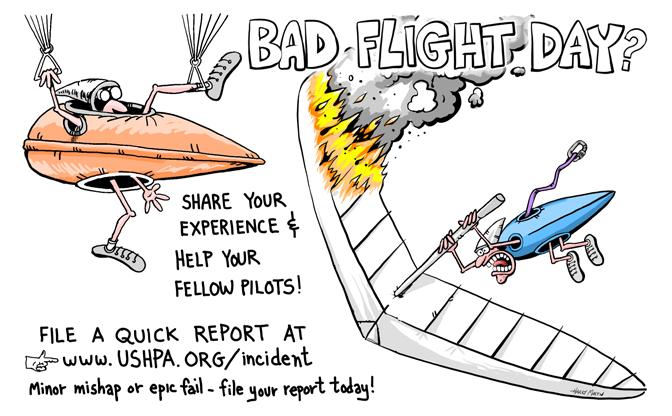
USHPA PILOT 65 64 USHPA PILOT
RTG RGN NAME STATE RATING OFFICIAL RTG RGN NAME STATE RATING OFFICIAL
Ratings Issued OCT, NOV & DEC 2023 (continued)
Jared Yates NC Calef Letorney P4 5 Milton Rafael Cerri NY Esau Diaz Guerrero P4 5 Brian Faenza NH Douglas Brown S1 2 Thomas West CA Jeff Katz S2 1 Conner Petersen WA Jeff Katz S2 3 Logan Gustafson CO Jeff Katz S2 3 Jeremy Little CA John E. Cady Iii S2 3 Ryan Macdougall CA Duane Hall S2 3 David Moeller CA Duane Hall
3 Eric Oleas CA John E. Cady Iii
3 Grant Vincent CO Jeff Katz
3 Gray
Duane Hall
S2
S2
S2
Zeldes CA
4
Katz
Hall
NJ John E.
RTG RGN NAME STATE RATING OFFICIAL RTG RGN NAME STATE RATING OFFICIAL P2 3 Vladimir Beliaev CO Johannes Rath P2 3
S2 5 Jimmy Hutfles
Cady Iii
Anett Berg CA Emily Wallace
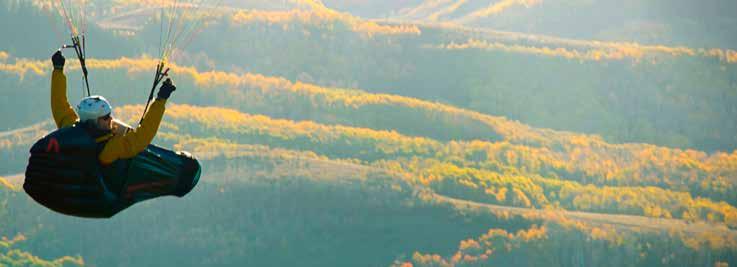
USHPA members rated H3/P3 and higher are eligible to increase their liability insurance limits to $1 million/$1 million. This increased coverage also includes extraterritorial coverage for international trips of up to 21 continuous days (for pilots rated 4/5 when increased limits are purchased).
Learn more at www.ushpa.org/member/insurance-members
WI Jaro Krupa
BAS INST PG 2 Chris Kennedy CA Kari L. Castle
TAND INST PG 3 Devin Joseph Nasby CA Jordan Neidinger
TAND INST PG Justin Caprari OR Jeffrey J. Greenbaum
TAND INST PG 2 Graham Shea CA Chris W. Santacroce
BAS INST HG 3 Cyndia Zumpft Klein CA Andrew T. Beem
TAND INST PG 5 Jonathan Kelley OH Jaro Krupa
TAND INST PG 2 Leo Gokovski UT Blake Pelton
ADV INST HG 2 Chris W. Santacroce UT Mel Glantz
BAS INST PG 2 John Tosti NV Dale Covington
TAND INST PG 5 Erick I. Sampaio MD John J. Gallagher
TAND INST PG 2 Mike Cozza CA Rob Sporrer
ADV INST PG 3 Jeremy Bishop CA Max Leonard Marien
TAND INST PG 3 Jeremy Bishop CA Max Leonard Marien
ADV INST HG 4 Michael Derek Howard FL Tiki Mashy
PL TECH1 HG 4 Michael Derek Howard FL Tiki Mashy
ST TECH1 HG 4 Michael Derek Howard FL Tiki Mashy
TAND INST HG 4 Michael Derek Howard FL Tiki Mashy
BAS INST PG 4 Jason R. Laughlin TX Brad Hill
TAND INST PG 4 Jason R. Laughlin TX Brad Hill
TAND INST PG 3 Doug Lidiak CO Charles Martin
TAND INST PG 2 Shane Healy UT Max Leonard Marien
TAND INST PG 1 Ryan Mullen WA Blake Pelton
TECH1 PG 3 Will Schaar Iii CO Chandler Papas
TECH2 PG 3 Will Schaar Iii CO Chandler Papas
TAND INST PG 2 Anant D. Asthana UT Blake Pelton
3 Misha Banks CO Gregory Kelley
INST PG 3 Misha Banks CO Gregory Kelley TAND INST
Take your ratings and expiration date everywhere you fly. View from the Members Area section of the USHPA website. Print, trim, and store in your wallet. Great for areas without cell coverage.
Always available at www.USHPA.org
Save the PDF on your mobile device for easy reference.
TAND INST PG 5 Beau Buck IN Scott C. Harris
TAND INST HG 5 Beau Buck IN Jon C. Thompson

USHPA PILOT 67 66 USHPA PILOT BAS INST PG 2 Pamela Kinnaird CA Gregory Kelley TAND INST HG 2 Paris Williams UT Zac Majors TAND INST PG 1 Kenneth Peterson WA Matt Senior TAND INST PG 3 Shawn C. Scott NM Blake Pelton TAND INST PG 3 Phill Bloom CA Jordan Neidinger TAND INST PG 5 Michael J. Jenovic OH Jaro Krupa TAND INST PG 2 Joshua Mallory UT Chris W. Santacroce TAND INST PG 3 Matthew Merina CA Jordan Neidinger TAND INST PG 3 Dan Corley CO Gregory Kelley TAND INST PG 2 David Blacklock CA Jesse L. Meyer TAND INST PG 2 Jakub Mazur CA Jesse L. Meyer TAND INST PG 2 Steven Mammano UT Blake Pelton BAS INST PG 2 Steven Mammano
Chris W. Santacroce ADV INST PG 3
INST PG
TAND INST PG
INST
INST PG
TECH2
CERTIFICATION RGN NAME STATE CERTIFYING OFFICIAL CERTIFICATION RGN NAME STATE CERTIFYING OFFICIAL
UT
Joe Louis Cary CO Gregory Kelley BAS
3 Xing Lin CA Max Leonard Marien
3 Xing Lin CA Max Leonard Marien BAS
SF 3 Jerome Daoust CA Christopher Grantham ADV
3 Jerome Daoust CA Christopher Grantham
PG 5 Paul Cooley WI Jaro Krupa TECH1 PG 4 Gregory J. Cusick FL Jaro Krupa TECH2 PG 4 Gregory J. Cusick FL Jaro Krupa TAND INST PG 2 Paul B. Egidio CA Rob Sporrer TAND INST PG 3 Chris Lorimer CA Rob Sporrer TECH1 PG 5 Kenneth Luebke
ADV
PG
Certifications Issued Oct, Nov & Dec 2023
INSURANCE FOR H3/P3 PILOTS


Elevate your adventure


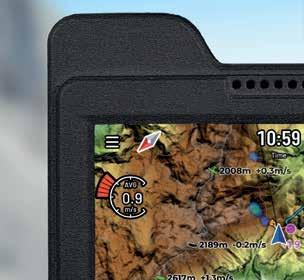
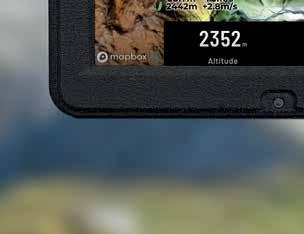



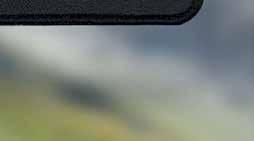
Smaller and lighter with the brains of the big ones. The new OMNI by Naviter.
More at www.naviter.com



68 USHPA PILOT 68 USHPA PILOT
flytec.com | 800.662.2449 | info@flytec.com


 Pinnacle Per formance, Light Weight
Pinnacle Per formance, Light Weight





















































































































